Lady Sheaffer 1958–1964: A Gallery
by Jim Mamoulides, January 23, 2023
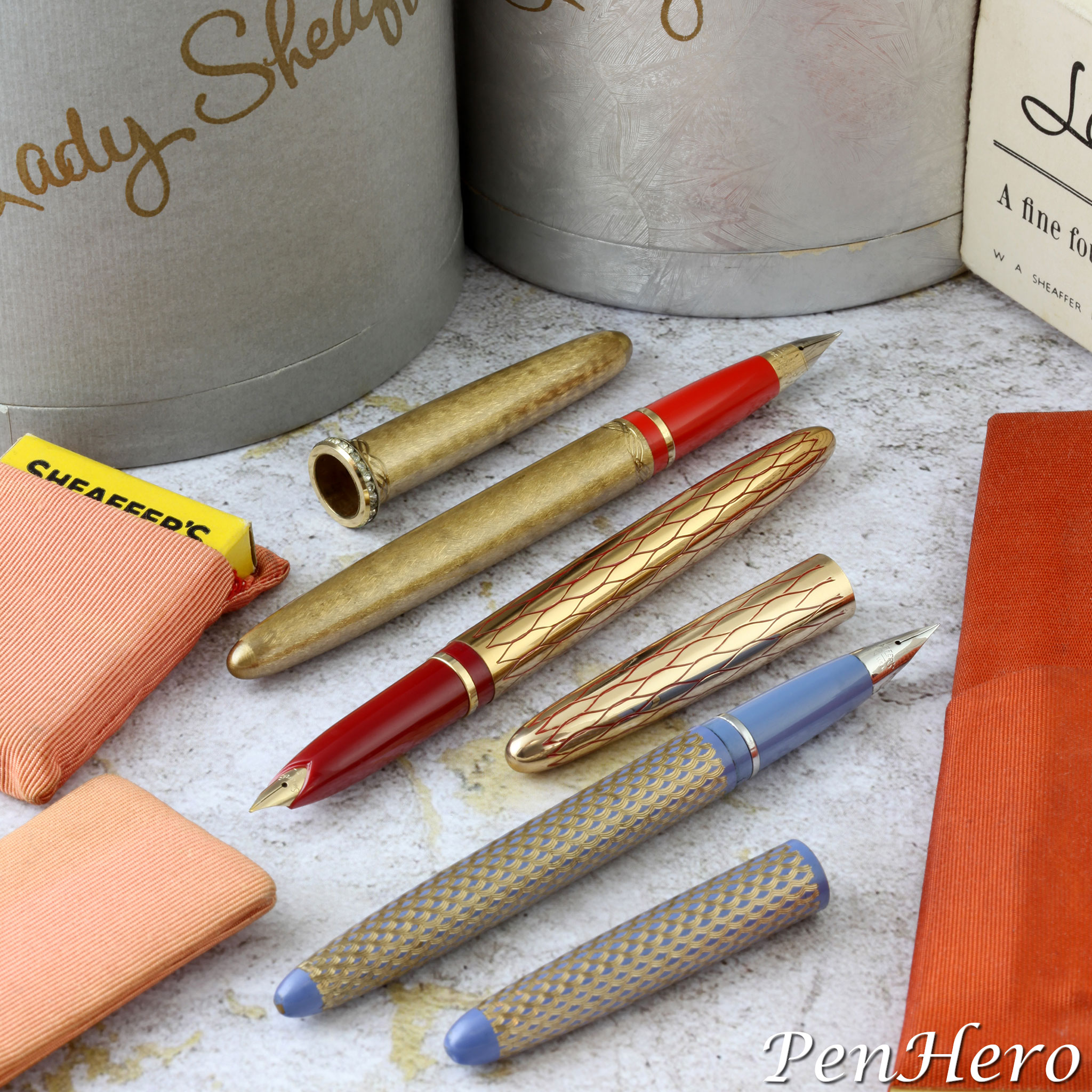 Lady Sheaffer XVI Moiré with Mandarin Red section; IX Balicon with red engraved net pattern and red section; VI Paisley in Periwinkle
Lady Sheaffer XVI Moiré with Mandarin Red section; IX Balicon with red engraved net pattern and red section; VI Paisley in Periwinkle
Sheaffer Goes High Fashion
The article “High Fashion Comes to the Pen Industry” in the March–April 1958 of Sheaffer’s Review tells the story of the rollout of Sheaffer’s first fountain pen line designed specifically for women as a fashion accessory. Sheaffer kicked off this new line on March 20, 1958, by inviting fashion editors of influential newspapers and magazines to a special press event. Sales launch meetings were then held in New York, New Orleans, Chicago, and San Francisco. The announcement was timed to coincide with the 50th anniversary of Walter Sheaffer’s 1908 lever-fill fountain pen invention.
With 19 clipless fountain pen models in popular colors including gold, silver, Jet Black, Ivory, Periwinkle, and Mandarin Red, and priced from $10 to $110 for the fountain pens, it was the broadest product line in Sheaffer history. The engraved pattern names evoke fine fabrics, including tweed, corduroy, paisley, tulle, moiré, brocade, spun silver, petit point, damask, and matelassé. Nibs grades included medium, fine, shorthand, and extra-fine.
The product launch aimed at expanding into a new market for Sheaffer: women’s fashion, jewelry, bridal, accessory, and cosmetic counters. Initial packaging was a tall, oval cardboard gift box lined with a gray suede-look fabric, similar to those used for perfumes and cosmetics. The boxes were labeled on the bottom with the model name and number, and various patterns were used on the outside, corresponding to the pen design. Inside, the pen was displayed upright in a hole in the base alongside a fabric purse case for the pen and the included matching pencil, as well as a matching fabric pouch to hold a box of Skrip ink cartridges, also included. The case and pouch were made in 11 different fabrics to complement each pen design.
The Lady Sheaffer advertisement in the May issue of Vogue was the first by Sheaffer in a fashion magazine. Ads were also run in Mademoiselle, Life, Reader’s Digest, The New Yorker, Ebony, This Week, and Parade. Newsreels were provided to movie theaters and television stations. Elaborate counter and window displays were distributed to traditional dealers and fashion counters. The line was shown in April 1958 at Expo 58, the Brussels World’s Fair, in Brussels, Belgium. All this combined to make this the biggest campaign in company history.
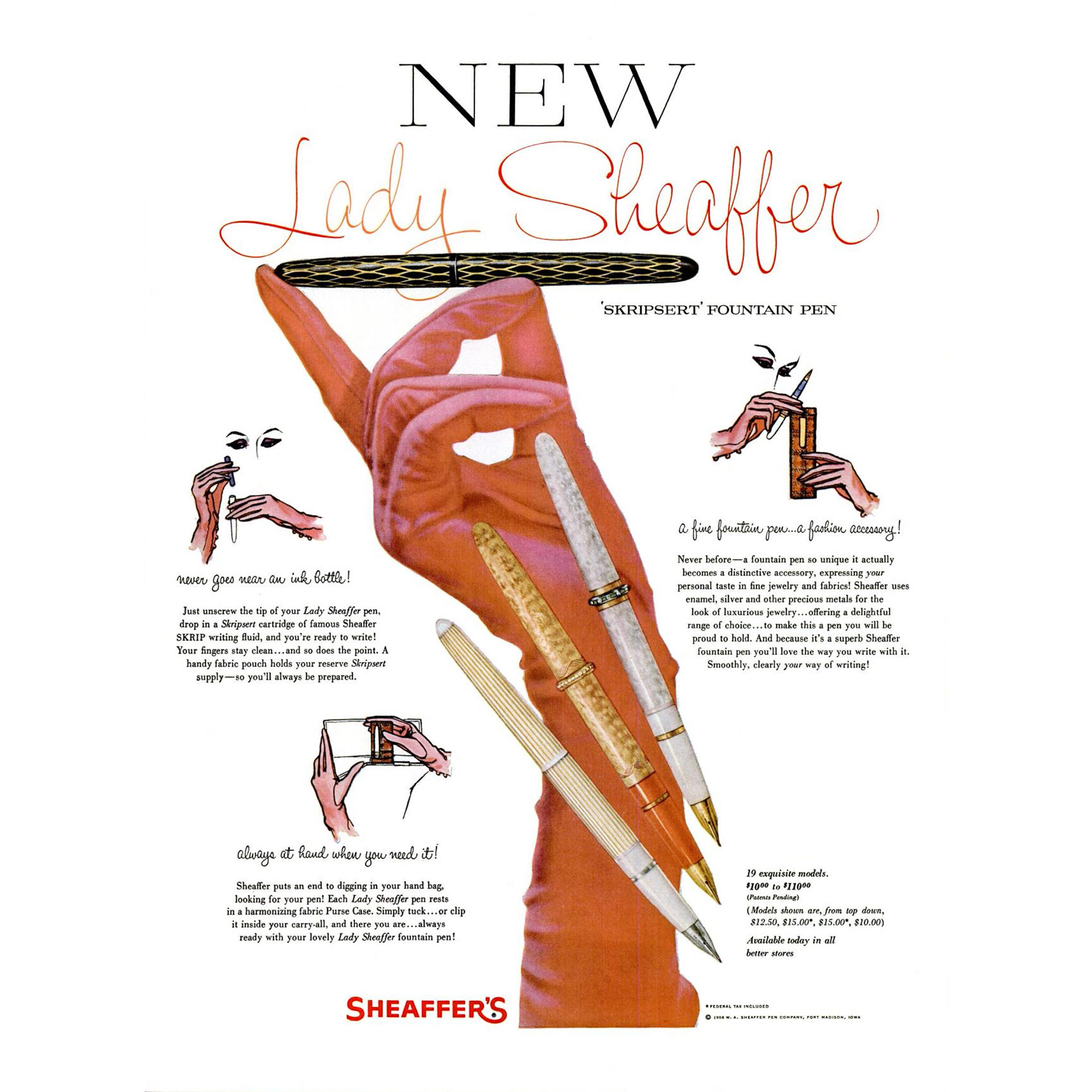 Life magazine advertisement, May 5, 1958, p. 63
Life magazine advertisement, May 5, 1958, p. 63
As told in the September 1958 Sheaffer’s Review, matching Lady Sheaffer pencils priced from $4.95 to $10 were added, the packaging was updated to include a display hole for the new pencil, and a new two-instrument pouch was added. Christmas packaging was introduced with a red, green and gold imprint.
The new Lady Sheaffer had a significant market impact, inspiring new women’s models from Papermate and Parker. David Kahn, Inc., which owned and manufactured Wearever, produced a knockoff of the Lady Sheaffer Tulle design called Lady Faire, complete with a vinyl purse case and counter displays similar to Sheaffer’s.
In May 1959, Sheaffer introduced a Golden Moiré Skripsert pen as part of a series of eight new Lenox Sheaffer Writing Sets, desk pen sets with Lenox China bases. Sheaffer also introduced a redesigned Skripsert cartridge fountain pen with the Stylpoint nib unit, where the section has a V-shaped cut revealing a small inset nib. This section would appear on the two Lady Sheaffer Balicon models introduced in 1963.
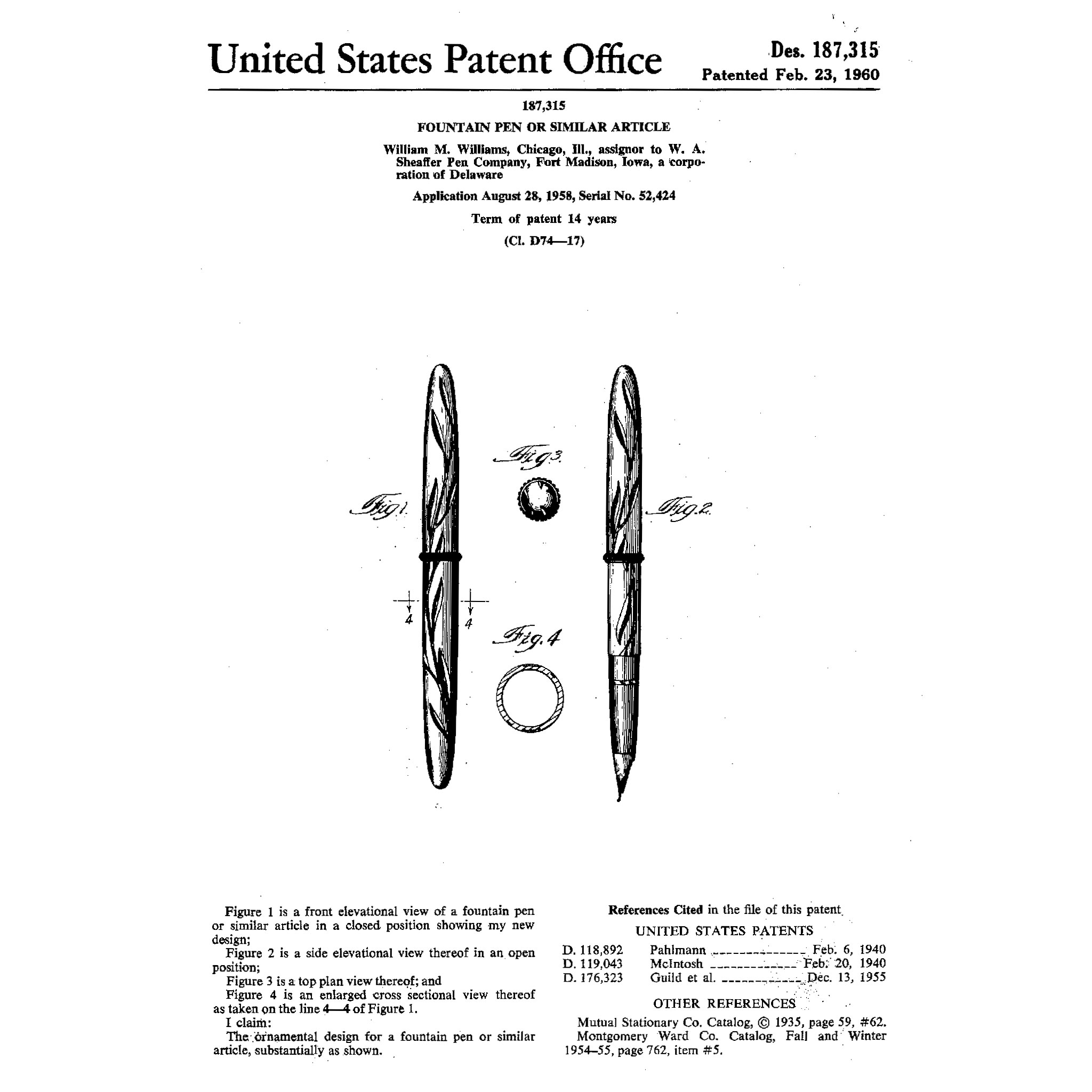 U.S. design patent no. D187315 for the Matelassé model, awarded February 23, 1960
U.S. design patent no. D187315 for the Matelassé model, awarded February 23, 1960
The 1959 Lady Sheaffer catalog shows 18 models, omitting the $110 Matelassé pen. It also has a photo showing the late 1958 counter display, which shows pen prices from $10 to $110, but the Matelassé pen is not in the display. Parts for the Matelassé, the Lady Sheaffer CX model, do not appear in the 1962 Sheaffer Service Manual. It is possible that the 14 karat gold cap and barrel pen was made only in the first year.
Identification Guide and Features
Following is a guide to the Lady Sheaffer pens and pencils with details on each of the 19 models. Sheaffer reduced the numbers of models available over the production period, with the Lady Sheaffer CX Matelassé possibly dropped as early as 1959. Date ranges are estimated from a review of newspaper and magazine advertisements and catalogs available from 1958 through 1967. This first Lady Sheaffer line tends to show worse quality than other contemporary Sheaffer models, with many showing plating and paint loss, inconstant finishing, loose cap to section fit, and engraving quality. Fine examples are quite beautiful and a pleasure to own. Sheaffer improved on this with later models with clips in the late 1960s.
Lady Sheaffer Skripsert fountain pen
- Metal cap and barrel with various fabric-inspired engraved, etched or brushed designs. Lacking manufacturing process information, references below will state the best guess based on the design.
- Color-coordinated plastic nib sections
- Nib grades included medium, fine, shorthand, and extra-fine
- Three conical point styles, all unhallmarked: no. 8 palladium silver and no. 9 gold were the standard nibs at launch in 1958; two-tone palladium plated gold nibs appeared later
- Two Stylpoint nib section styles: no. 18 stainless steel and no. 19 gold plated stainless steel, used on the Balicon model c. 1963 to 1964
- Uses Sheaffer Skrip cartridges
- About 5 3/8 inches long capped
- Sold in tall oval paperboard boxes from 1958 to c. 1961, plastic clamshell boxes from c. 1962 to 1963, and by 1964 in standard Sheaffer presentation boxes with Lady Sheaffer markings
- There are at least thirteen known unique fabric pouches made, indicating that each model had a specific matching pouch.
Lady Sheaffer pencil
- Metal cap and barrel with various fabric-inspired engraved designs
- Twist advance/retract mechanism
- Eraser under cap
- Sold in same packaging with pens; unknown if sold separately
List of Models
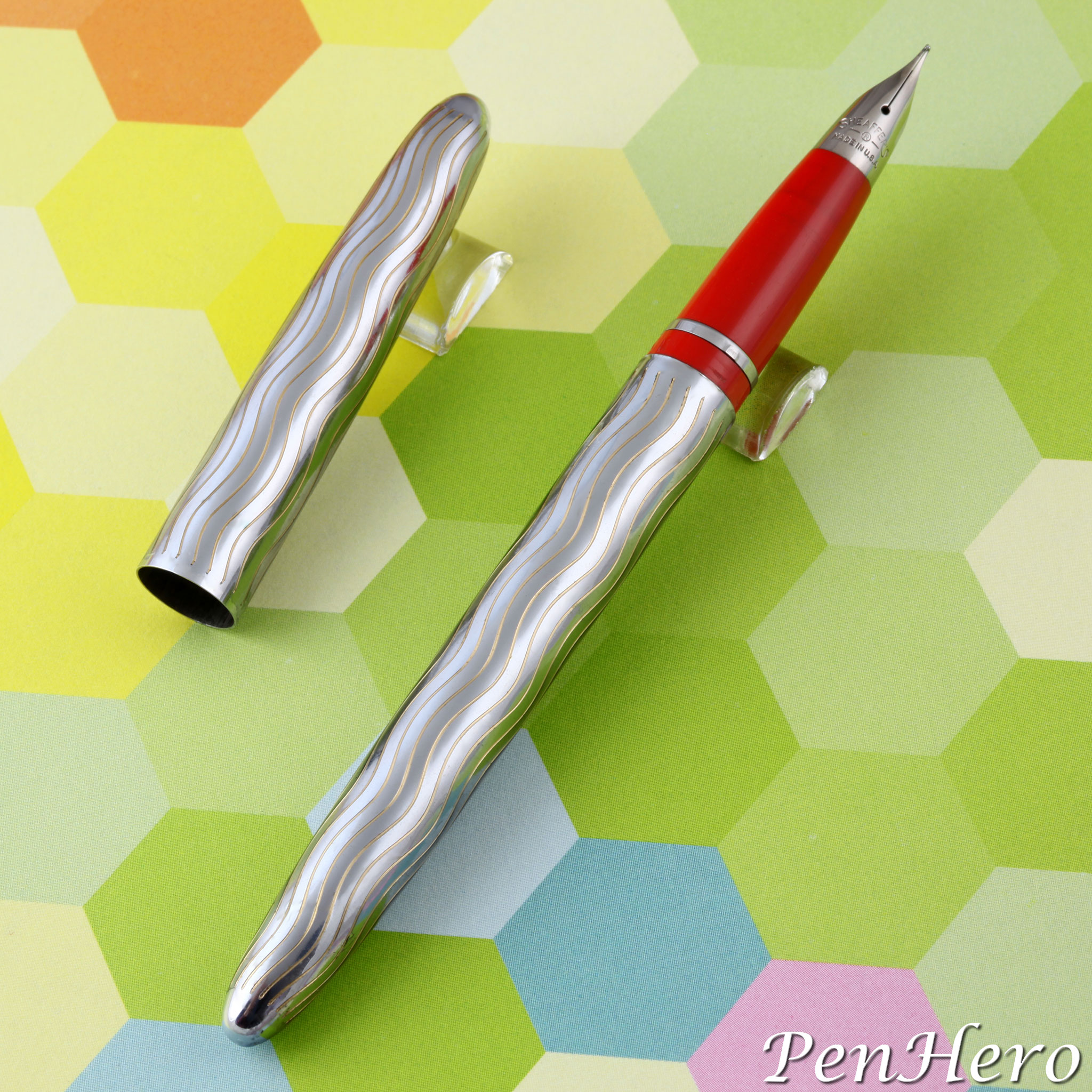
 Lady Sheaffer I Tweed
Lady Sheaffer I Tweed
Lady Sheaffer I Tweed c. 1958–60: Named for tweed, a rough surfaced woven woolen fabric typically made in mixed colors. Parallel engraved wave lines with gold fill on silver (chrome plate). Vermilion plastic nib section, Sheaffer’s no. 19 Vermilion color, and palladium silver nib. $10.00 for the fountain pen and $4.95 for the matching pencil.
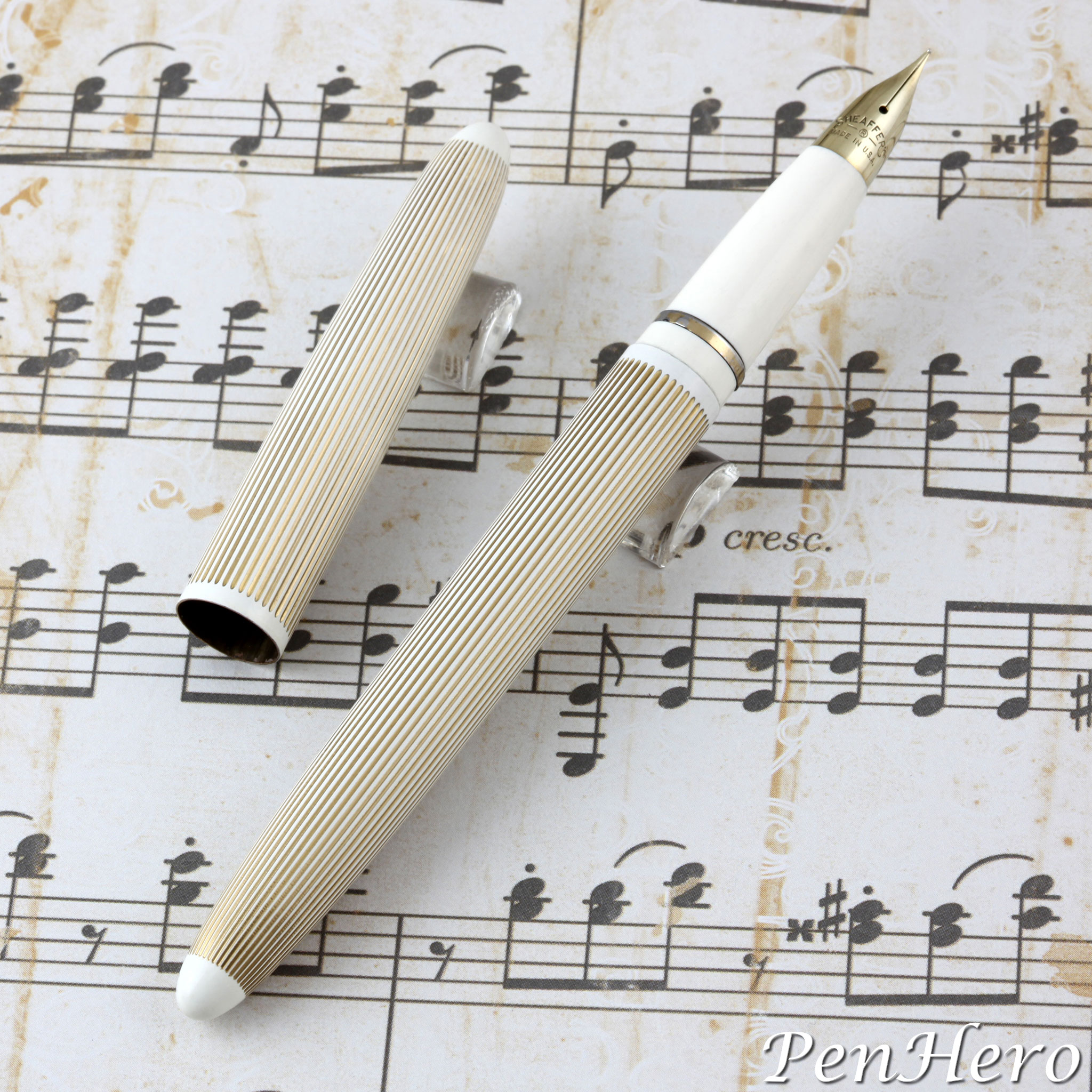
 Lady Sheaffer II Corduroy
Lady Sheaffer II Corduroy
Lady Sheaffer II Corduroy c. 1958–60: Named for corduroy, a cotton fabric with lengthwise cords or ridges. Parallel engraved straight gold-filled lines on an Ivory (also called White in the 1962 Sheaffer Service Manual) enamel finish. Ivory plastic nib section, Sheaffer’s no. 5 White color, and palladium silver nib. $10.00 for the fountain pen and $4.95 for the matching pencil.
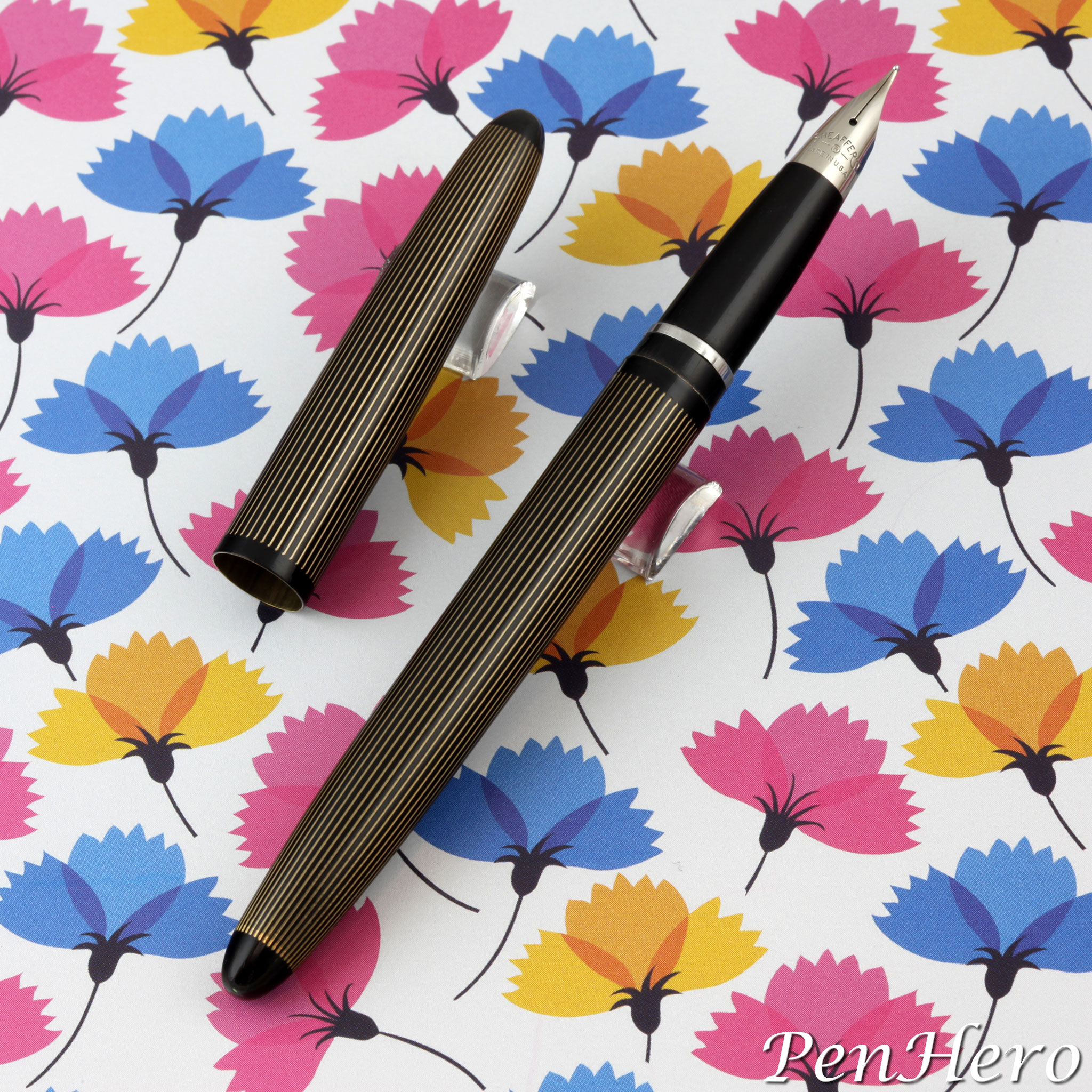
 Lady Sheaffer III Corduroy
Lady Sheaffer III Corduroy
Lady Sheaffer III Corduroy c. 1958–60: Parallel engraved straight gold lines on a Jet enamel finish. Jet black plastic nib section, Sheaffer’s no. 11 black color, and palladium silver nib. $10.00 for the fountain pen and $4.95 for the matching pencil.
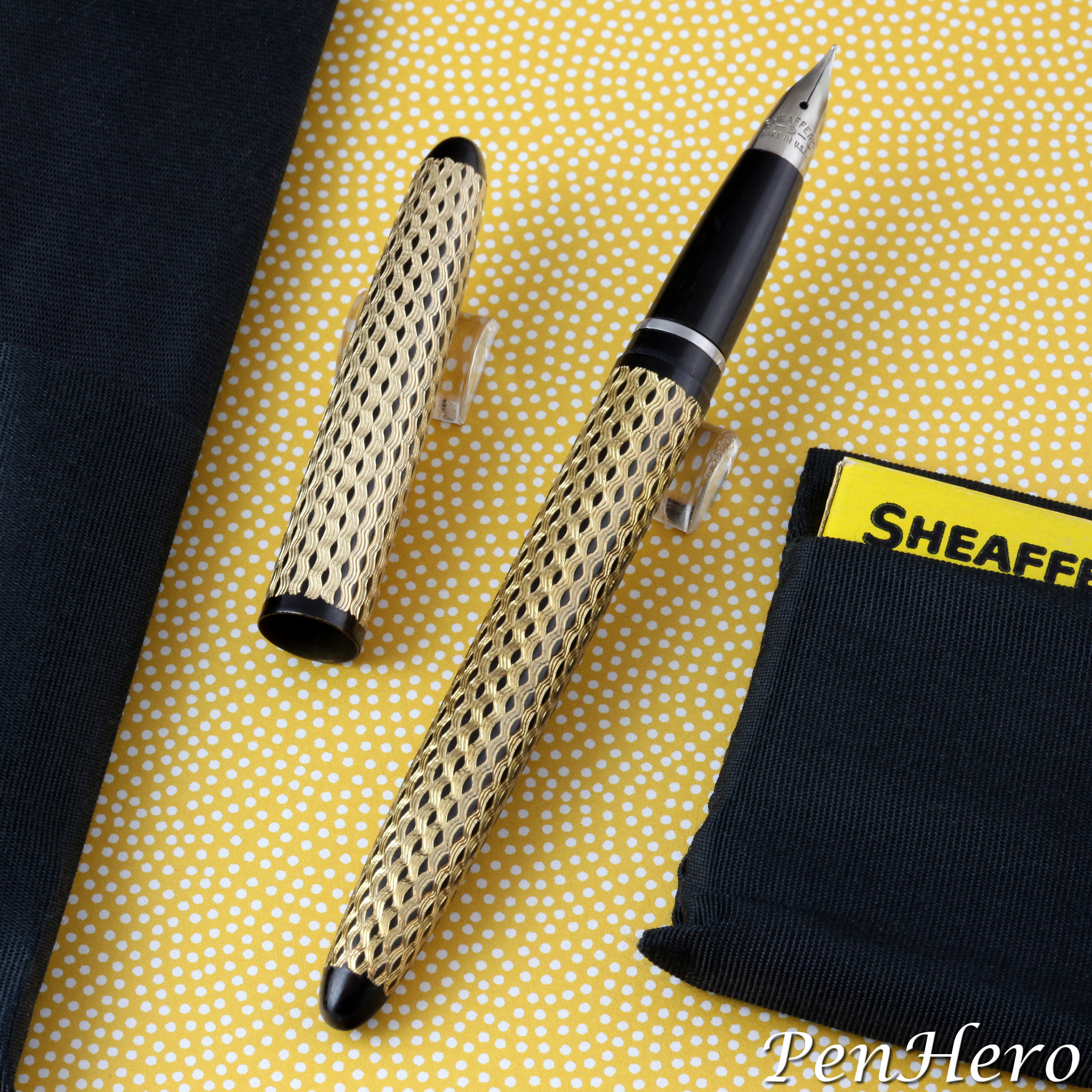
 Lady Sheaffer IV Paisley
Lady Sheaffer IV Paisley
Lady Sheaffer IV Paisley c. 1958–66: Named for paisley, a woolen fabric woven with a pattern of colorful and minutely detailed figures. Dense tight repeating engraved gold wave pattern on a Jet enamel finish. Jet black plastic nib section, Sheaffer’s no. 11 black color, and palladium silver nib. $10.00 for the fountain pen and $4.95 for the matching pencil.
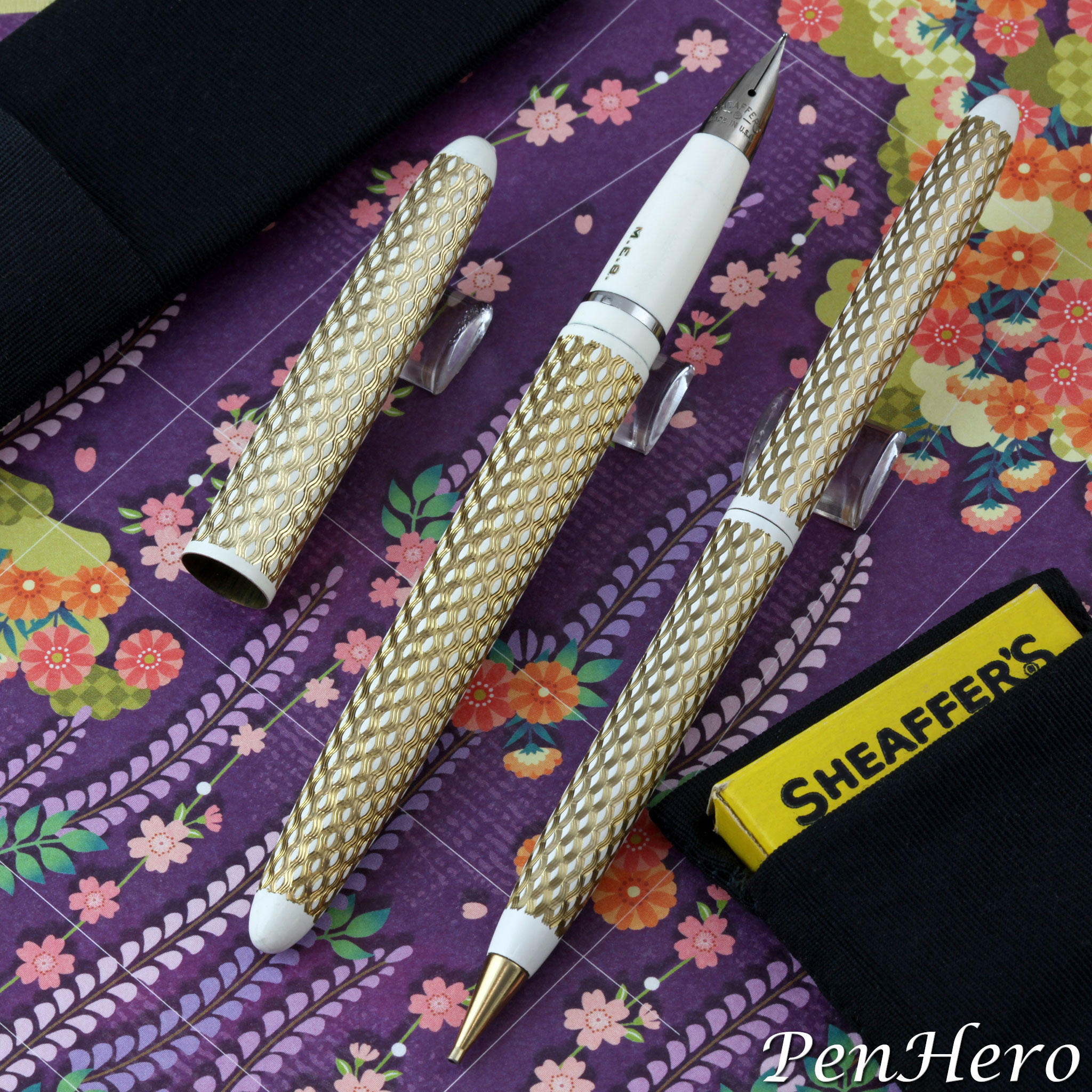
 Lady Sheaffer V Paisley
Lady Sheaffer V Paisley
Lady Sheaffer V Paisley c. 1958–66: Dense tight repeating engraved gold wave pattern on an Ivory enamel finish. Ivory color plastic nib section, Sheaffer’s no. 5 white color, and palladium silver nib. $10.00 for the fountain pen and $4.95 for the matching pencil.
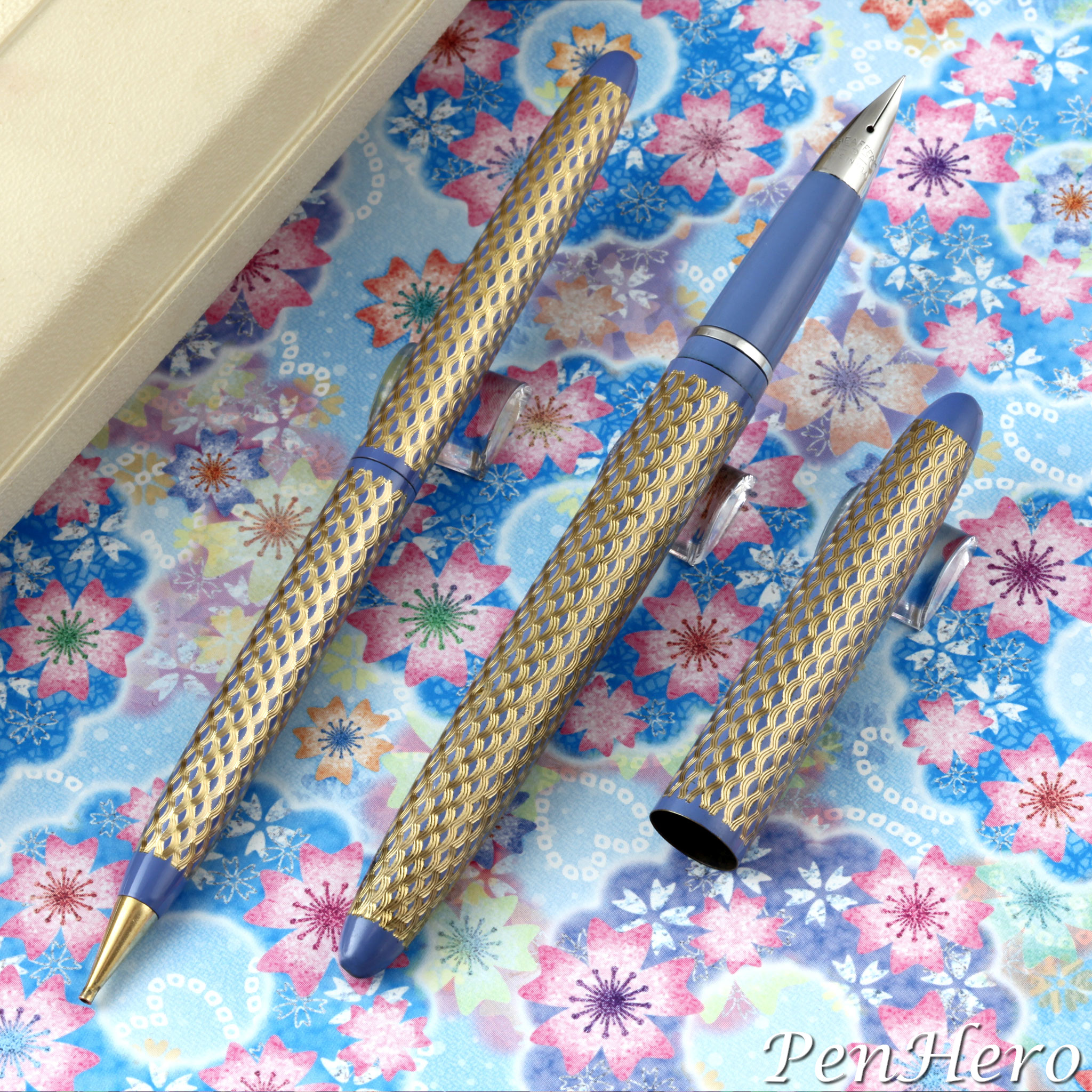
 Lady Sheaffer VI Paisley
Lady Sheaffer VI Paisley
Lady Sheaffer VI Paisley c. 1962–66: Dense tight repeating engraved gold wave pattern on a Periwinkle enamel finish. Periwinkle color plastic nib section, Sheaffer’s no. 18 Periwinkle color, and a palladium silver nib. $10.00 for the fountain pen and $4.95 for the matching pencil.
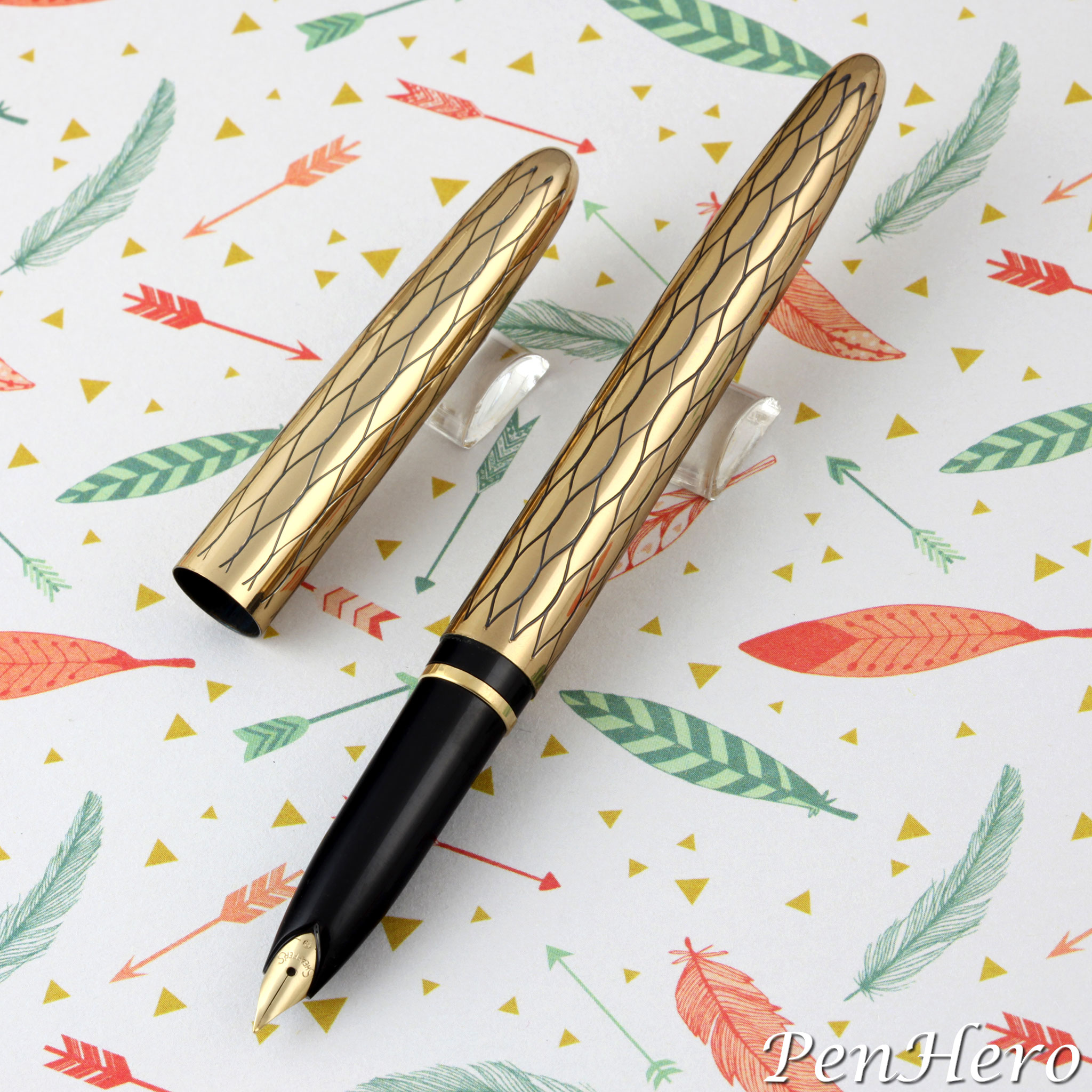
 Lady Sheaffer VIII Balicon
Lady Sheaffer VIII Balicon
Lady Sheaffer VIII Balicon c. 1962–66 The Balicon name is a departure from naming Lady Sheaffer models after fabrics and weaves and actually has no dictionary definition. Polished gold-plated finish with an engraved net pattern in black. Black plastic nib section and inset gold Stylpoint nib. $7.95 for the fountain pen and $5.00 for the matching pencil.
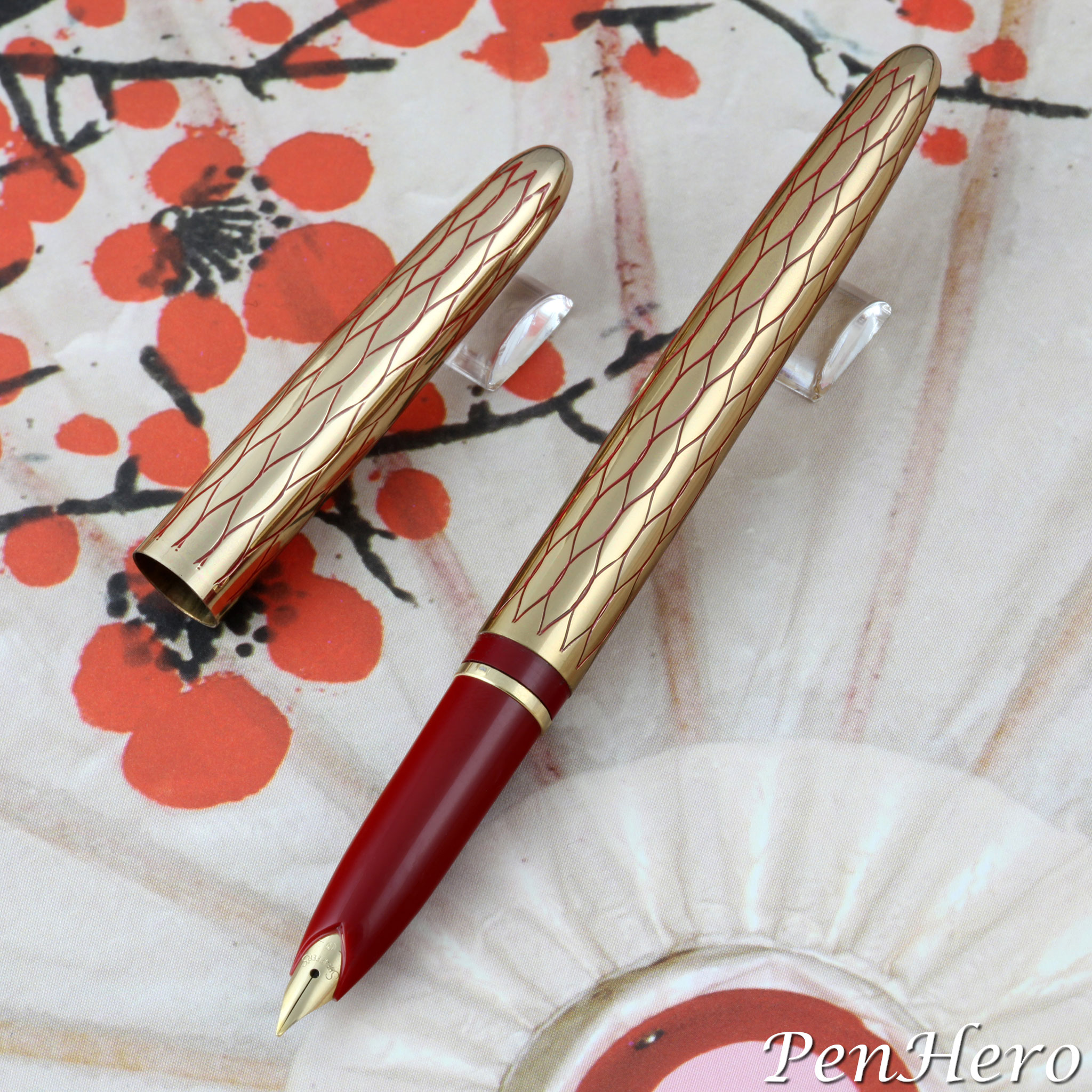
 Lady Sheaffer IX Balicon
Lady Sheaffer IX Balicon
Lady Sheaffer IX Balicon c. 1962–66: Polished gold-plated finish with an engraved net pattern in red. Red plastic nib section and inset gold Stylpoint nib. $7.95 for the fountain pen and $5.00 for the matching pencil.
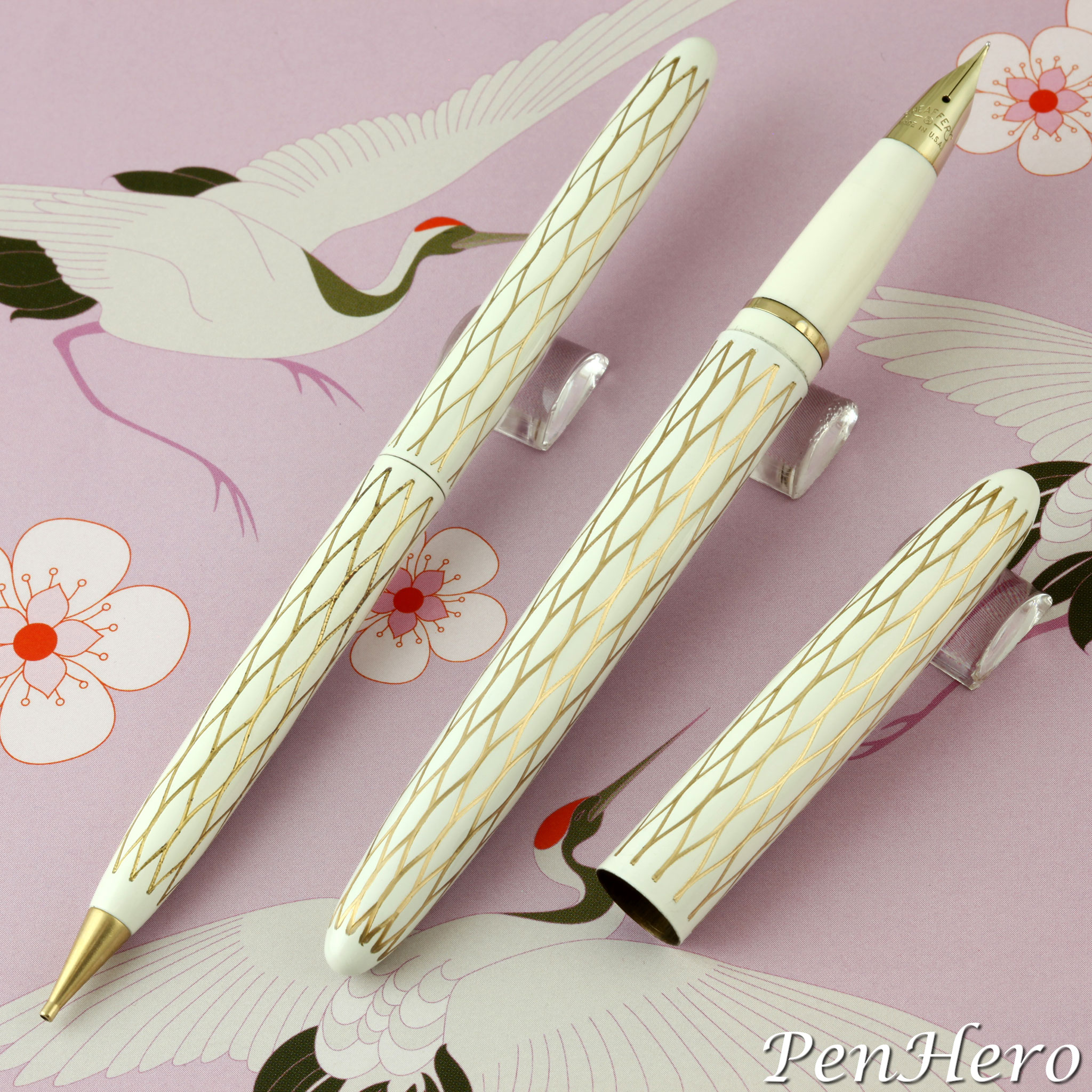
 Lady Sheaffer X Tulle
Lady Sheaffer X Tulle
Lady Sheaffer X Tulle c. 1958–66: Tulle is a thin, fine net named after Tulle, France, where the fabric was first made. Engraved gold net pattern on an Ivory enamel finish. Ivory color plastic nib section, Sheaffer’s no. 5 white color, and a gold nib. $12.50 for the fountain pen and $5.00 for the matching pencil.
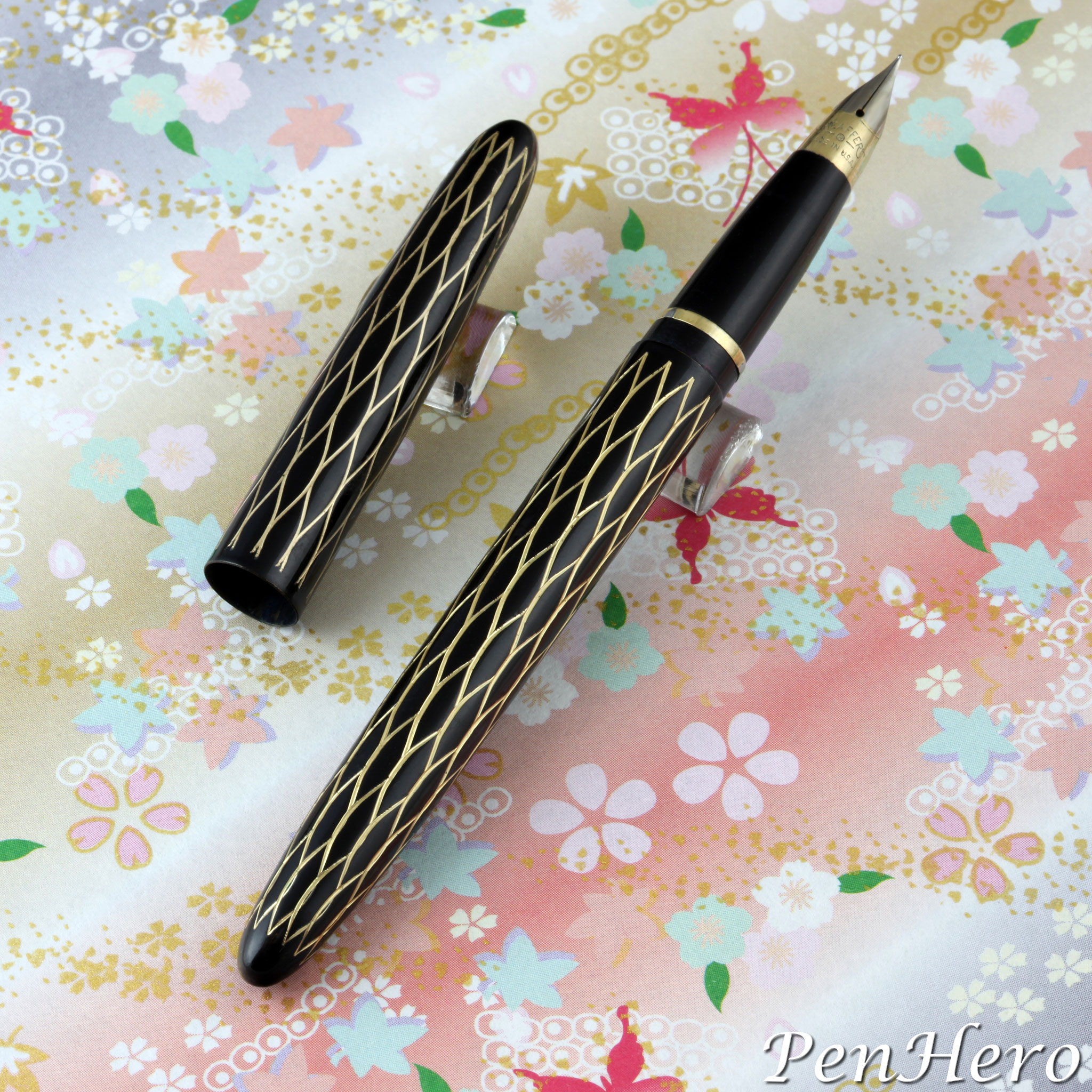
 Lady Sheaffer XI Tulle
Lady Sheaffer XI Tulle
Lady Sheaffer XI Tulle c. 1958–66: Engraved gold net pattern on a Jet enamel finish. Jet black plastic nib section, Sheaffer’s no. 11 black color, and a gold nib. $12.50 for the fountain pen and $5.00 for the matching pencil.
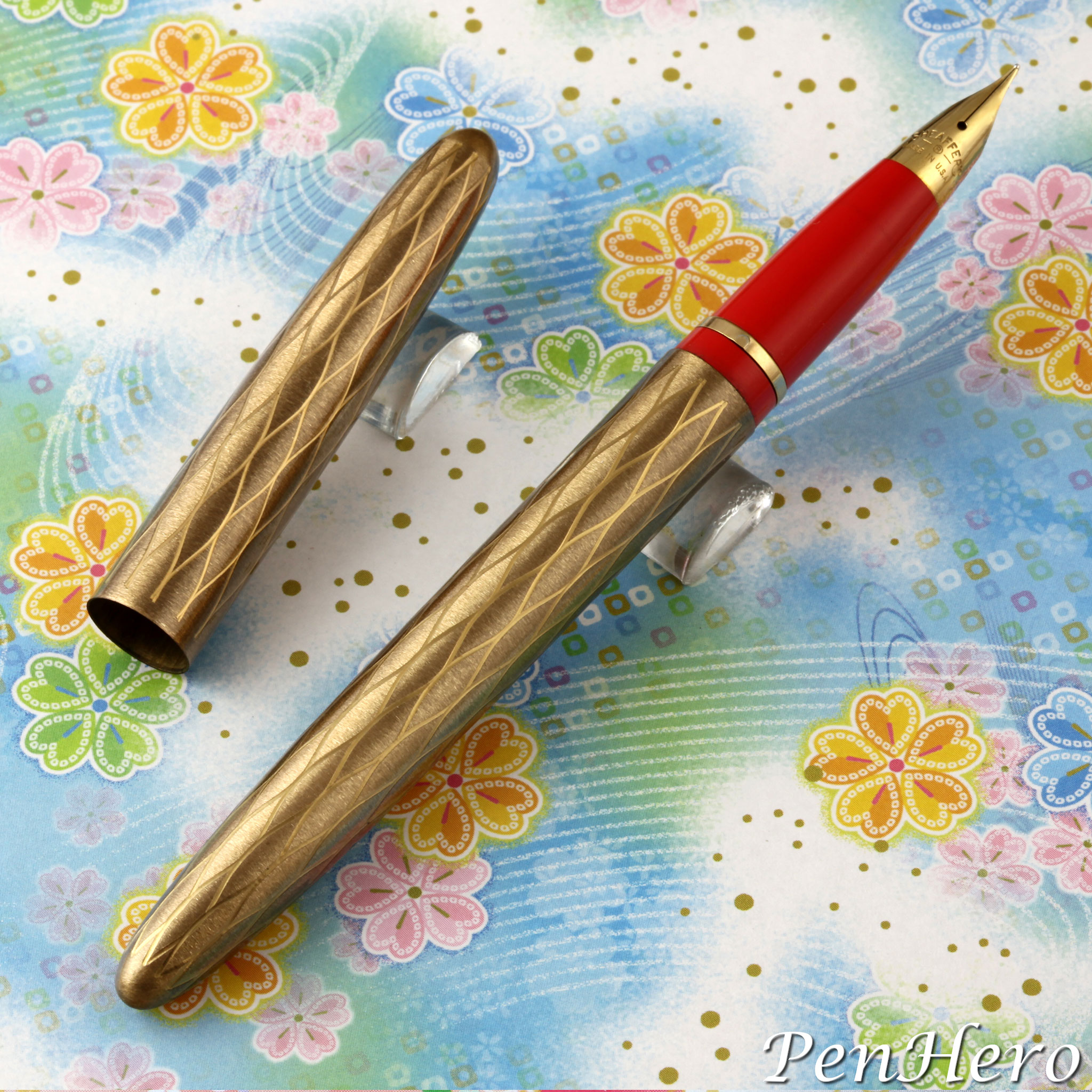
 Lady Sheaffer XII Tulle
Lady Sheaffer XII Tulle
Lady Sheaffer XII Tulle c. 1958–66: Engraved gold net pattern on a gold-plated finish. Vermilion color plastic nib section, Sheaffer’s no. 19 Vermilion color, and a gold nib. $12.50 for the fountain pen and $5.00 for the matching pencil.
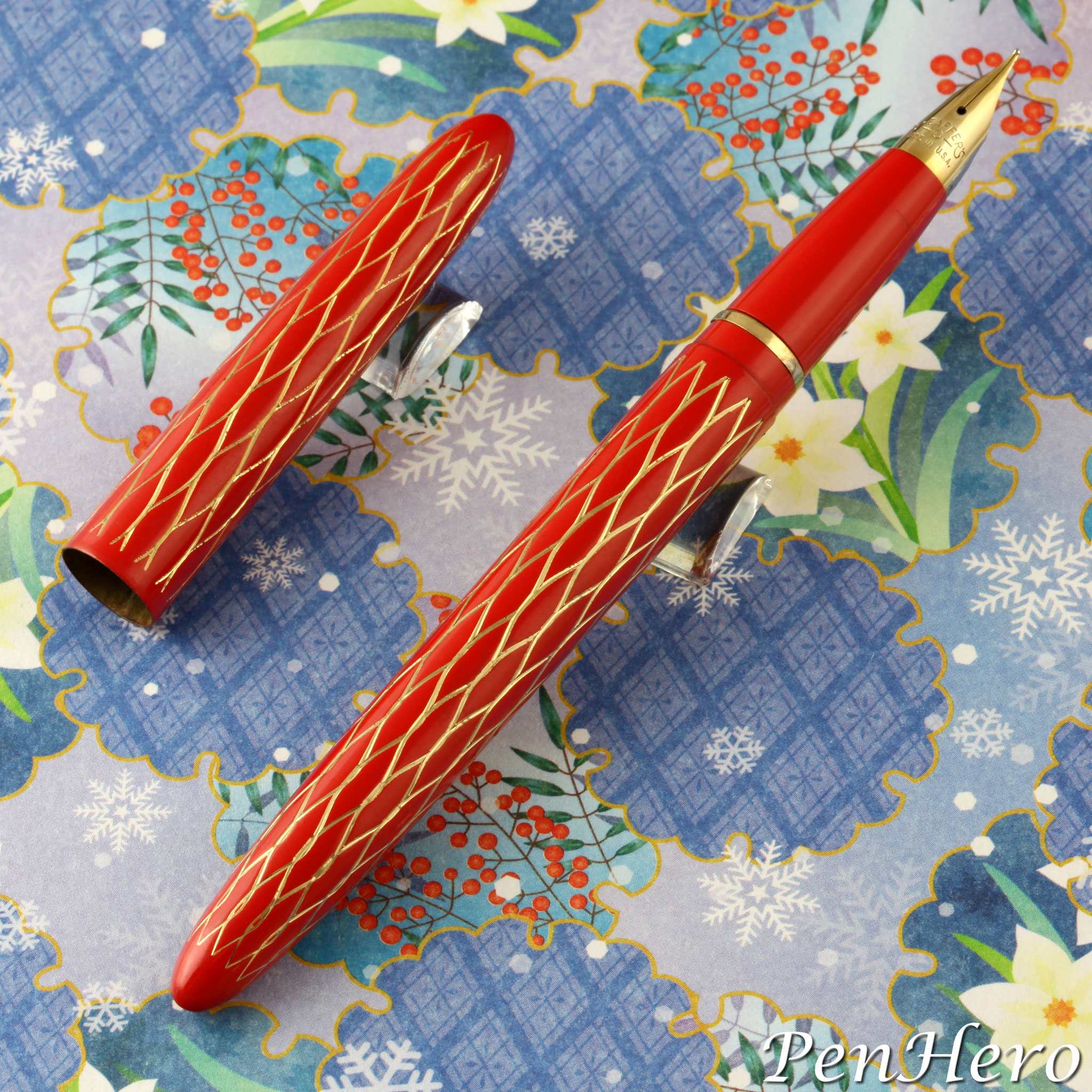
 Lady Sheaffer XIV Tulle
Lady Sheaffer XIV Tulle
Lady Sheaffer XIV Tulle c. 1958–66: Engraved gold net pattern on a Mandarin Red enamel finish. Vermilion color plastic nib section, Sheaffer’s no. 19 Vermilion color, and a gold nib. $12.50 for the fountain pen and $5.00 for the matching pencil.
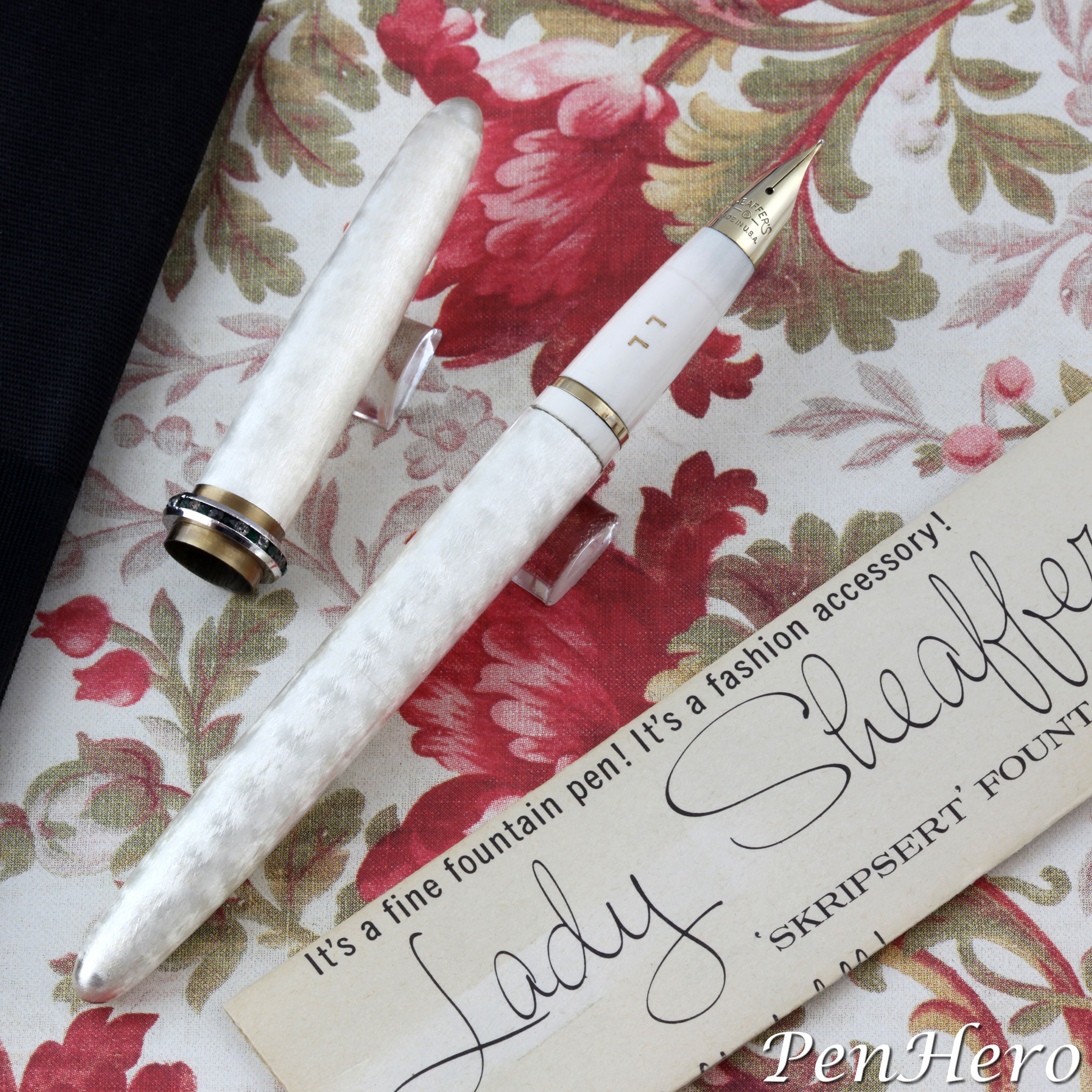
 Lady Sheaffer XV Moiré with blue and clear rhinestones
Lady Sheaffer XV Moiré with blue and clear rhinestones
 Lady Sheaffer XV Moiré with green and clear rhinestones
Lady Sheaffer XV Moiré with green and clear rhinestones
 Lady Sheaffer XV Moiré with amber and clear rhinestones
Lady Sheaffer XV Moiré with amber and clear rhinestones
 Lady Sheaffer XV Moiré with red and clear rhinestones
Lady Sheaffer XV Moiré with red and clear rhinestones
Lady Sheaffer XV Moiré c. 1958–60: Moiré is a fabric, usually silk, with a wavy (watered) appearance created by a finishing technique called calendering. Brushed or etched moiré pattern on a silver-colored finish, a gold-plated center band with a raised ring filled with rhinestones. The 1962 Sheaffer Repair Manual says they are multicolor. Examples exist indicating four different rhinestone color sets: blue and clear, red and clear, green and clear, and amber (possibly orange) and clear. Ivory color plastic nib section, Sheaffer’s no. 5 white color, and a gold nib. $15.00 for the fountain pen and $7.50 for the matching pencil.
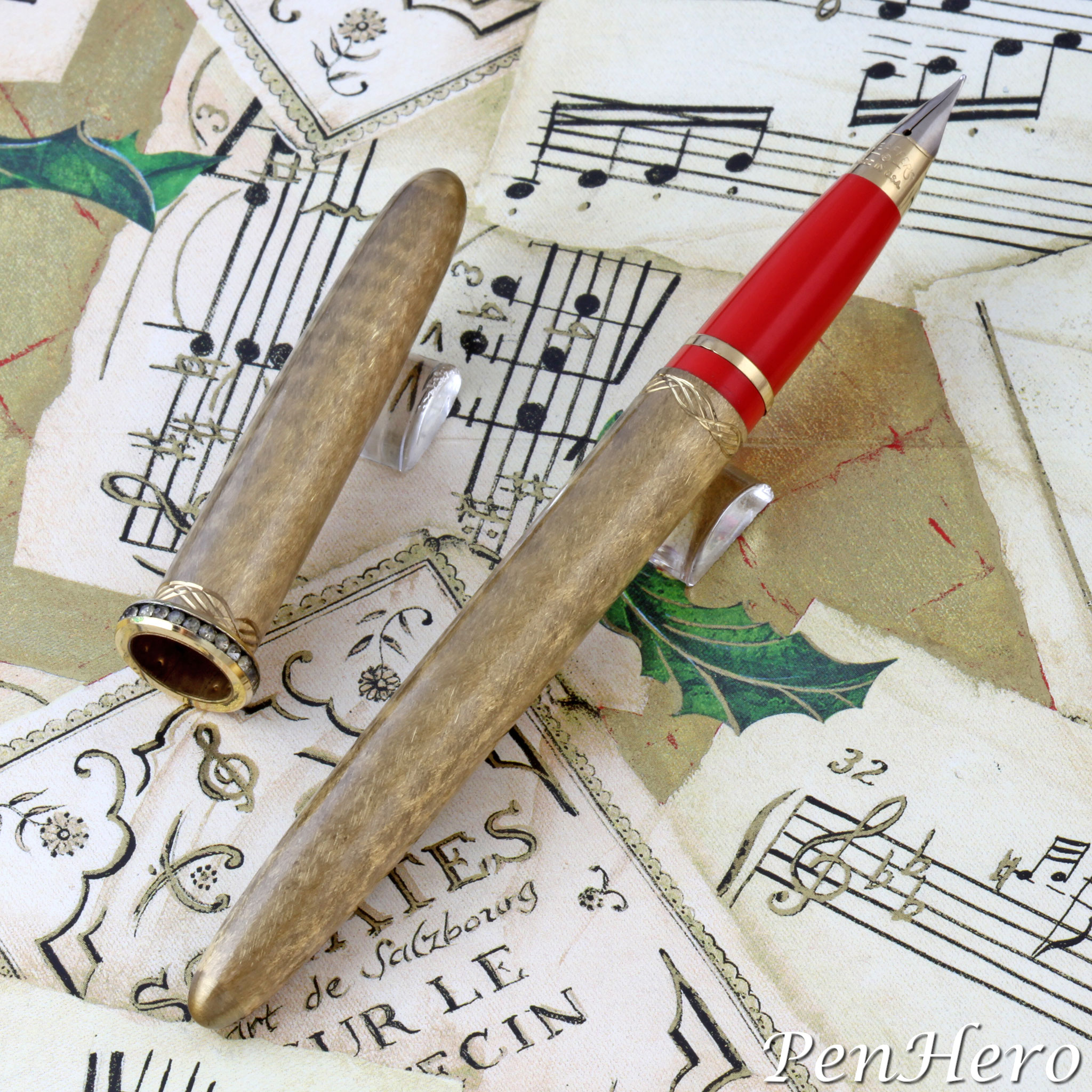
 Lady Sheaffer XVI Moiré
Lady Sheaffer XVI Moiré
Lady Sheaffer XVI Moiré c. 1958–60: Brushed or etched moiré pattern on a gold-colored finish, a gold-plated center band with a raised ring filled with clear rhinestones. Vermilion color plastic nib section, Sheaffer’s no. 19 Vermilion color, and a gold nib. $15.00 for the fountain pen and $7.50 for the matching pencil.
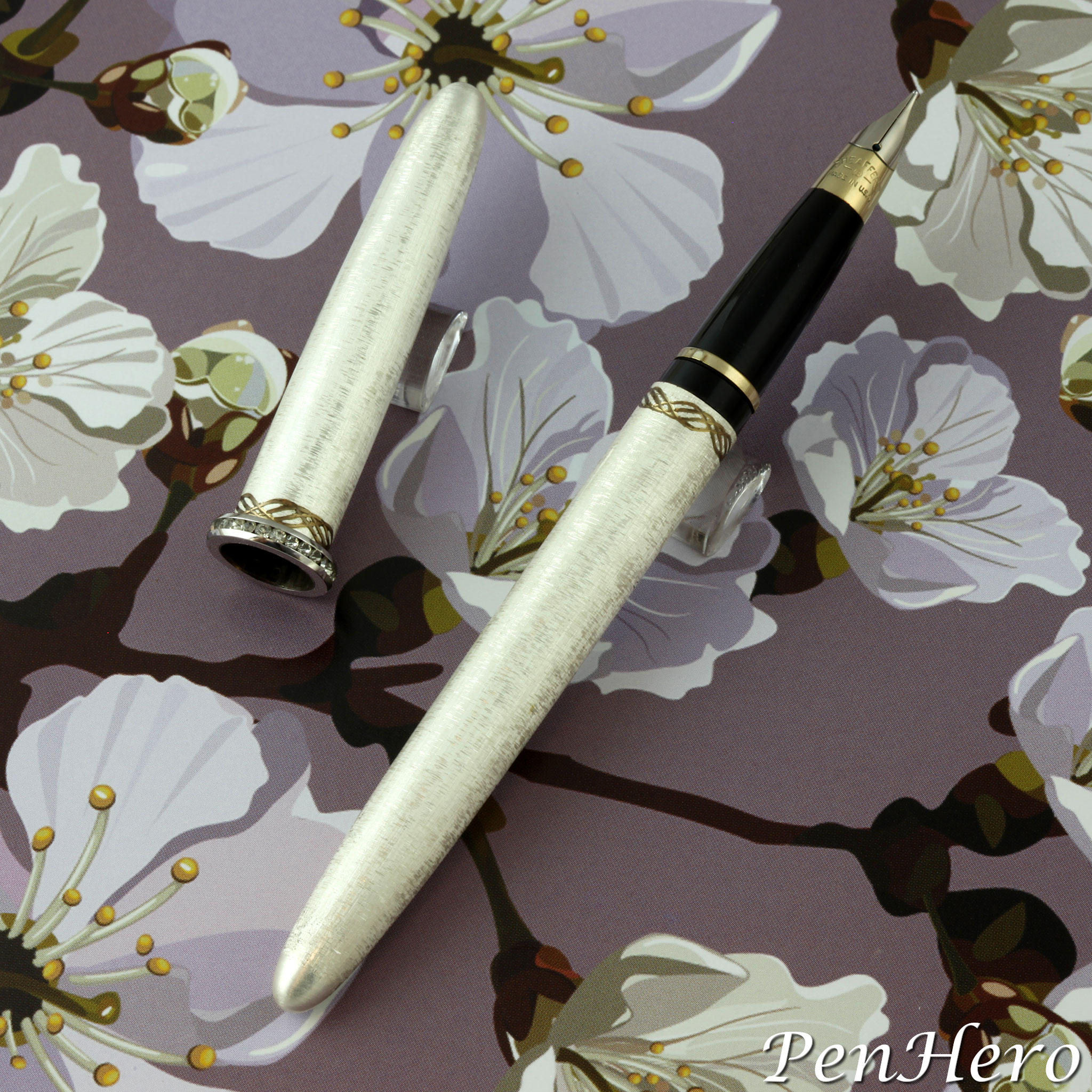
 Lady Sheaffer XVII Brocade
Lady Sheaffer XVII Brocade
Lady Sheaffer XVII Brocade c. 1958–60 Brocade is a fabric woven with an elaborate design, especially with a raised pattern. Brushed or etched brocade pattern on a silver color finish, a gold-plated center band with a raised ring filled with clear rhinestones. Jet black plastic nib section, Sheaffer’s no. 11 black color, and a gold nib. $15.00 for the fountain pen and $7.50 for the matching pencil.
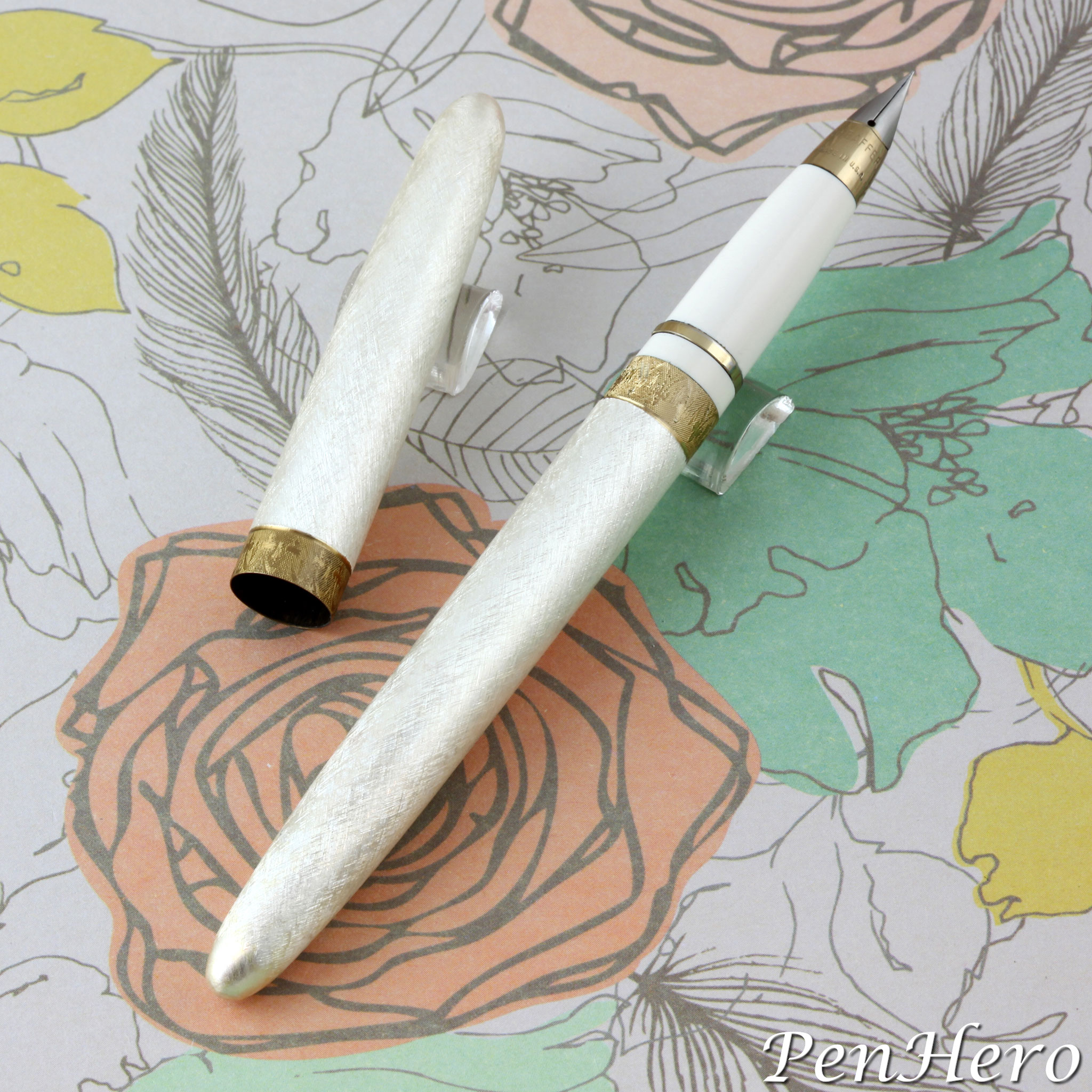
 Lady Sheaffer XX Satin
Lady Sheaffer XX Satin
Lady Sheaffer XX Satin c. 1958–60: Satin is a fabric woven in in such a way that the filling threads are interlaced with the warp at widely separated intervals, producing the effect of an unbroken surface— typically glossy with a dull back. Brushed or etched satin pattern on a silver color finish, gold-plated inlay center bands. Ivory color plastic nib section, Sheaffer’s no. 5 white color, and a gold nib. $20.00 for the fountain pen and $7.50 for the matching pencil.
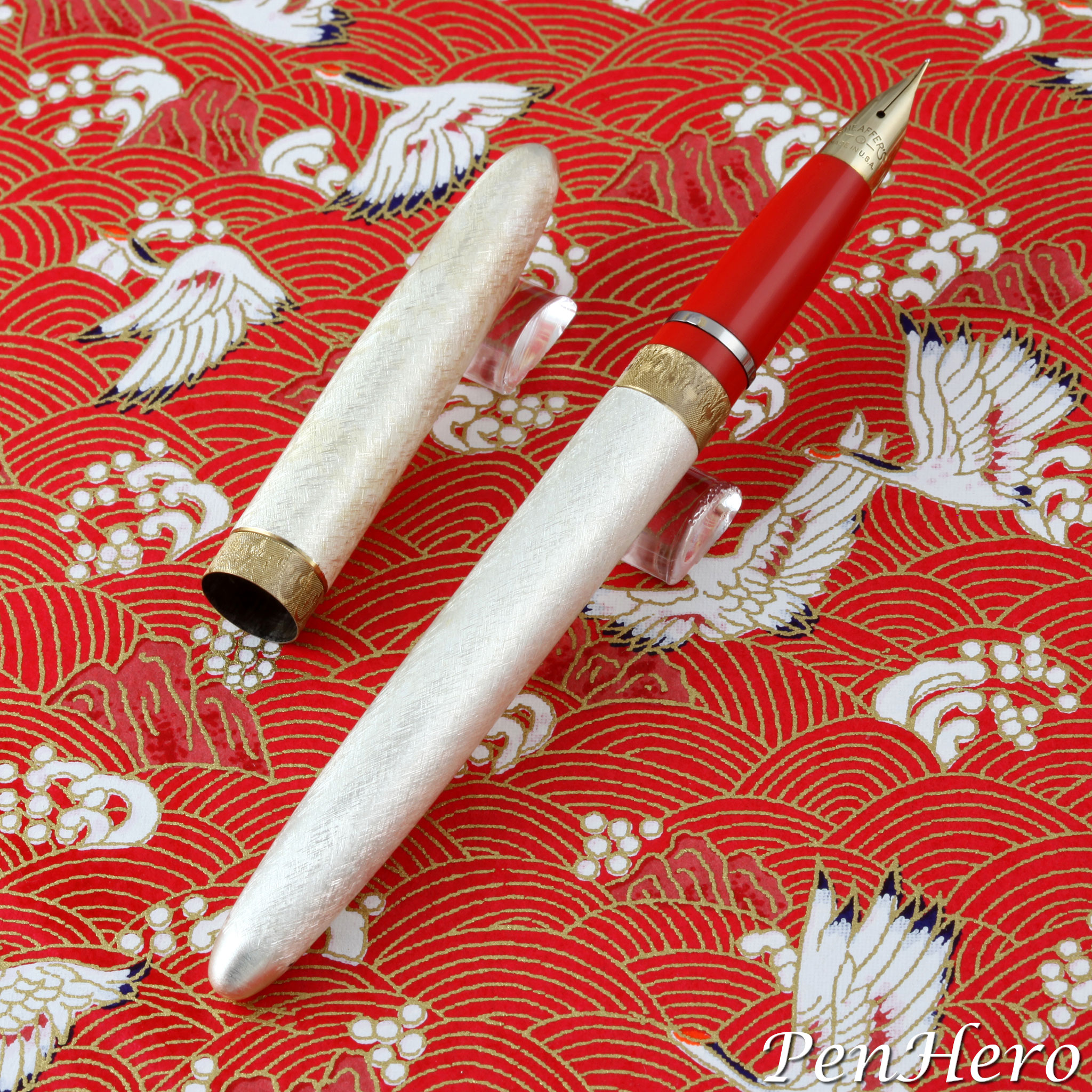
 Lady Sheaffer XXI Satin
Lady Sheaffer XXI Satin
Lady Sheaffer XXI Satin c. 1958–60: Brushed or etched satin pattern on a silver color finish, gold-plated inlay center bands. Vermilion color plastic nib section, Sheaffer’s no. 19 Vermilion color, and a gold nib. $20.00 for the fountain pen and $7.50 for the matching pencil.
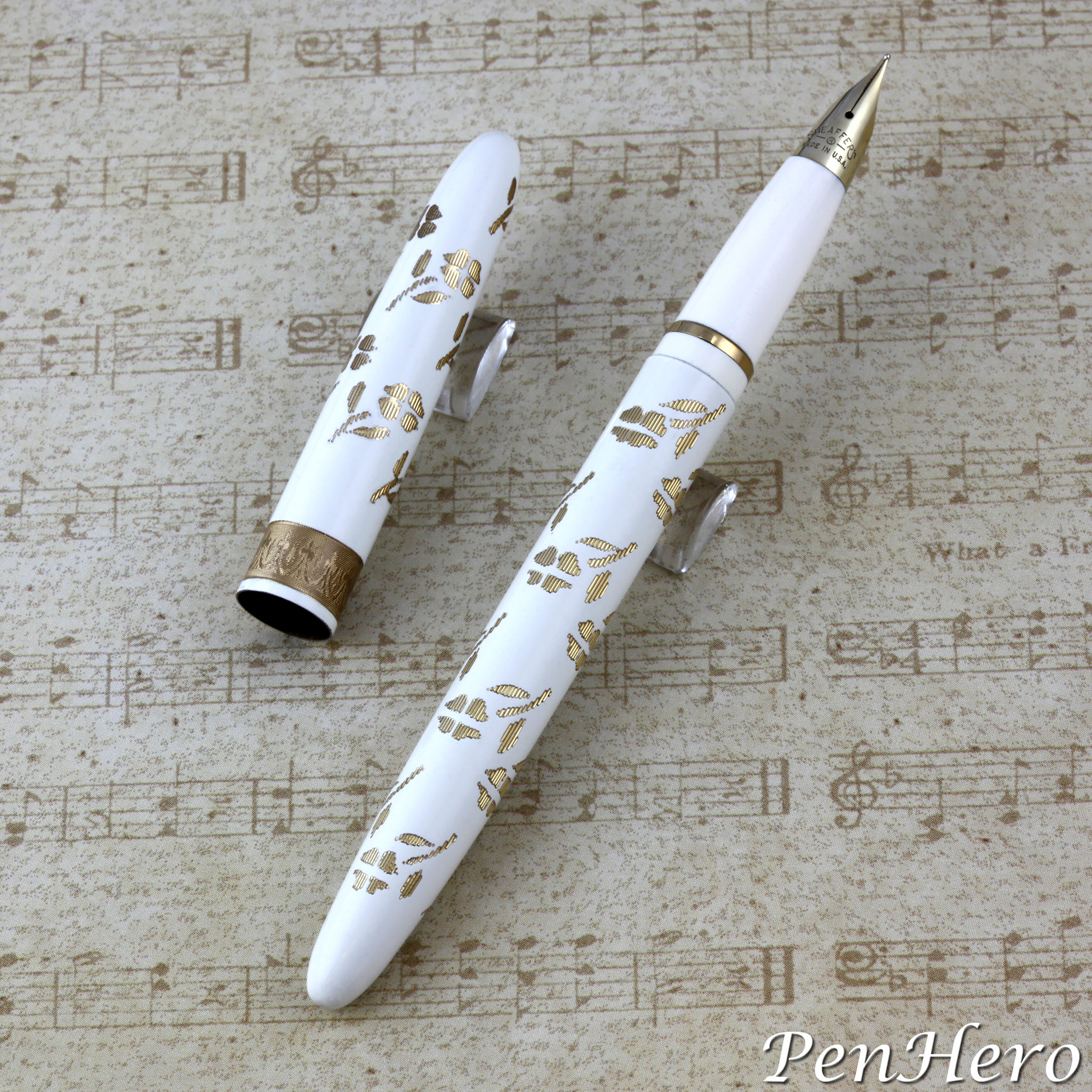
 Lady Sheaffer XXIII Petit Point
Lady Sheaffer XXIII Petit Point
Lady Sheaffer XXIII Petit Point c. 1958–60: Petit Point, French for “small point” or “dot,” is embroidery done on a canvas backing resembling woven tapestry. Engraved gold-filled floral embroidery pattern on an Ivory enamel finish and an engraved gold-plated cap band. Ivory color plastic nib section, Sheaffer’s no. 5 white color, and a gold nib. $27.50; there was no cataloged matching pencil.
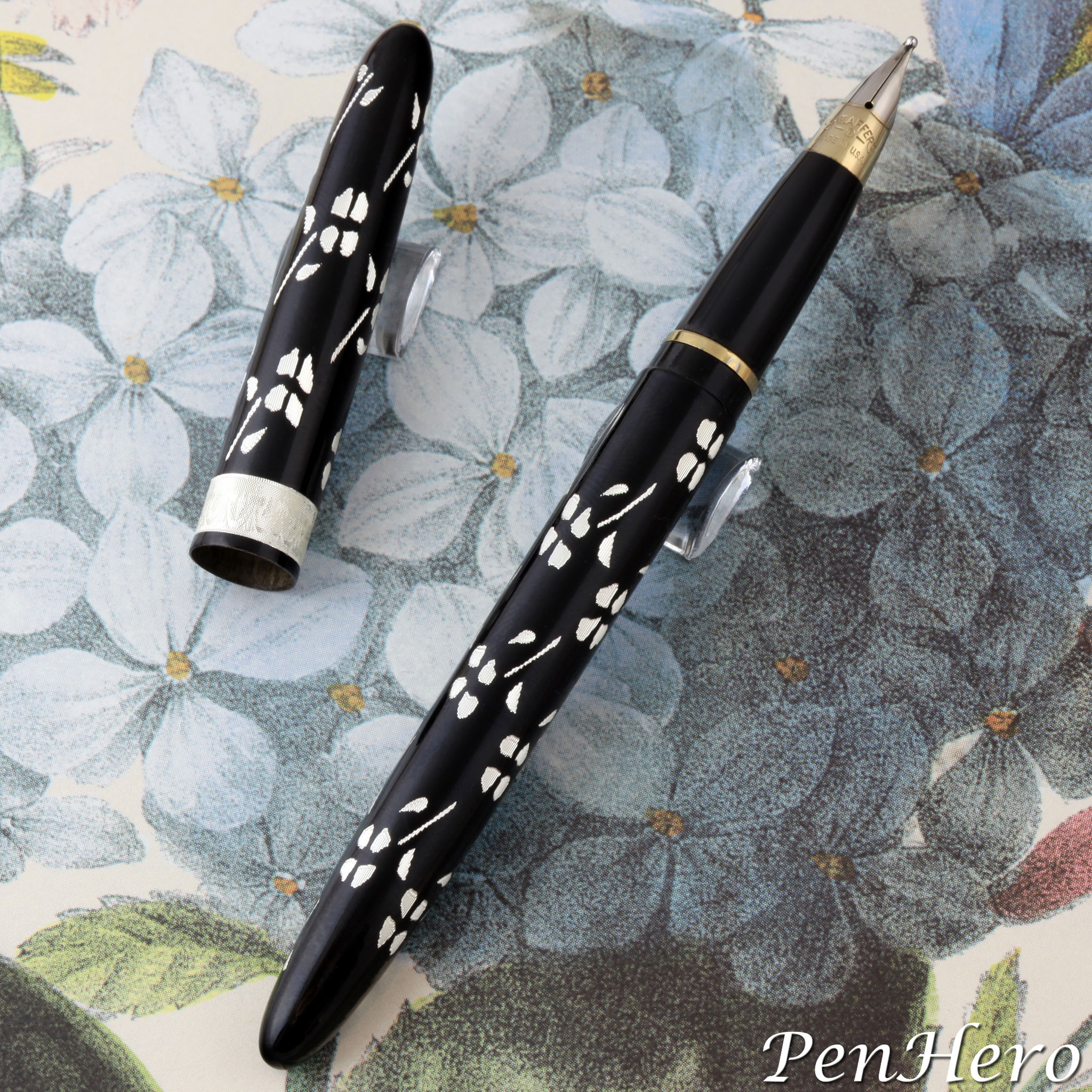
 Lady Sheaffer XXIV Petit Point
Lady Sheaffer XXIV Petit Point
Lady Sheaffer XXIV Petit Point c. 1958–60: Engraved white floral embroidery pattern on a Jet enamel finish and one engraved white enameled cap band. Jet black plastic nib section, Sheaffer’s no. 11 black color, and a gold nib. $27.50; there was no cataloged matching pencil.
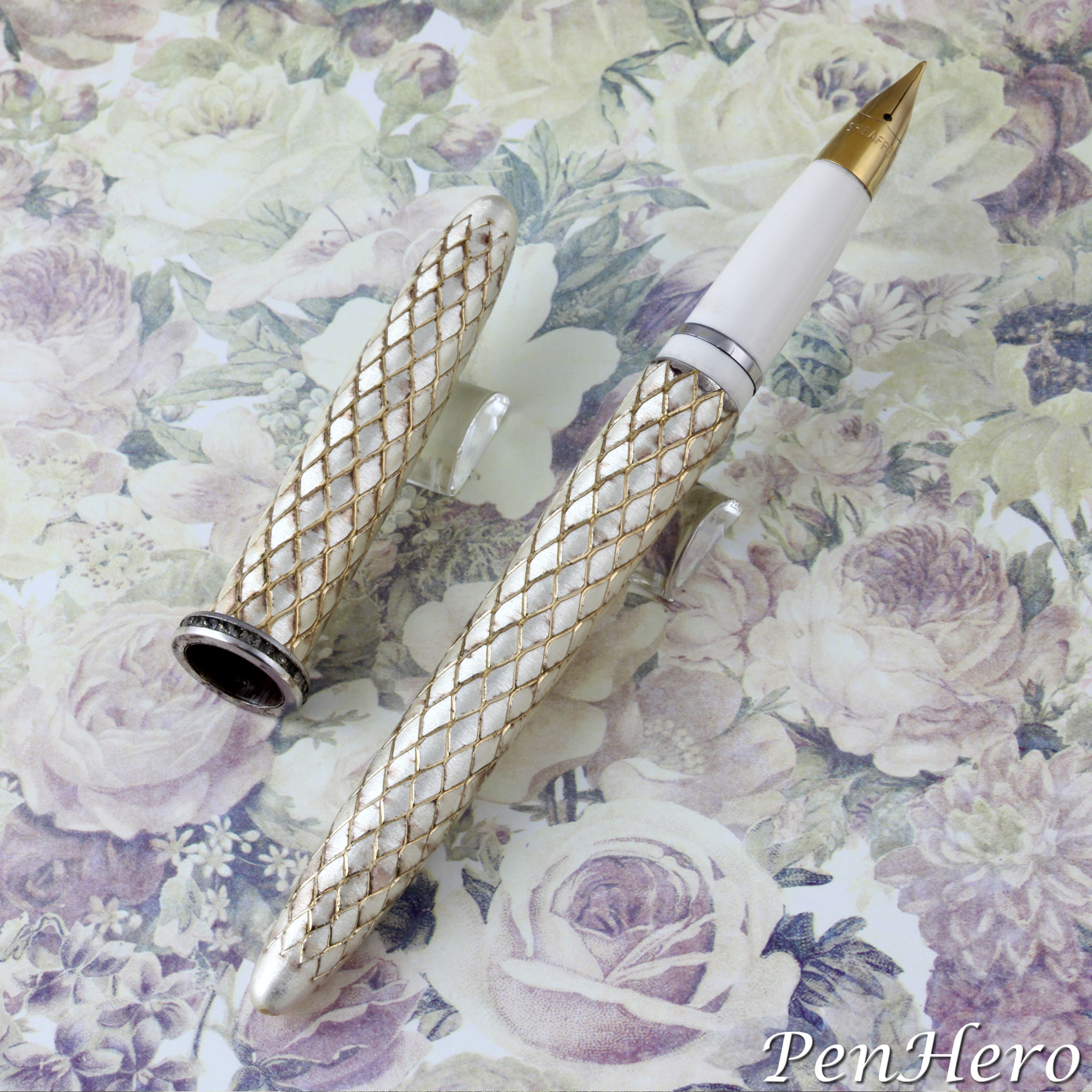
 Lady Sheaffer XXXV Damask
Lady Sheaffer XXXV Damask
Lady Sheaffer XXXV Damask c. 1958–60: Damask is a reversible woven patterned fabric made of linen, silk, cotton, or wool. Engraved gold diamond pattern on a silver color finish, raised ring filled with clear rhinestones. Ivory color plastic nib section, Sheaffer’s no. 5 white color, and a gold nib. $35.00 for the fountain pen and $10.00 for the matching pencil.
 Lady Sheaffer CX Matelassé
Lady Sheaffer CX Matelassé
Lady Sheaffer CX Matelassé c. 1958: Matelassé is a double cloth fabric marked by raised floral or geometric designs with a quilted appearance. It has a hand-carved 14 karat gold cap and barrel with sterling silver inlays in a floral wave pattern and a raised ring probably filled with clear rhinestones. The design was awarded U.S. patent no. D187315 on February 23, 1960. The nib section is either Ivory color plastic, Sheaffer’s no. 5 White color, or Jet black plastic, Sheaffer’s no. 11 black color, and the nib is gold. The fountain pen sold for $110.00 and possibly only at Tiffany’s. There was no matching pencil. The Matelassé does not appear in the 1959 Lady Sheaffer catalog nor in the point of sale displays.
Performance
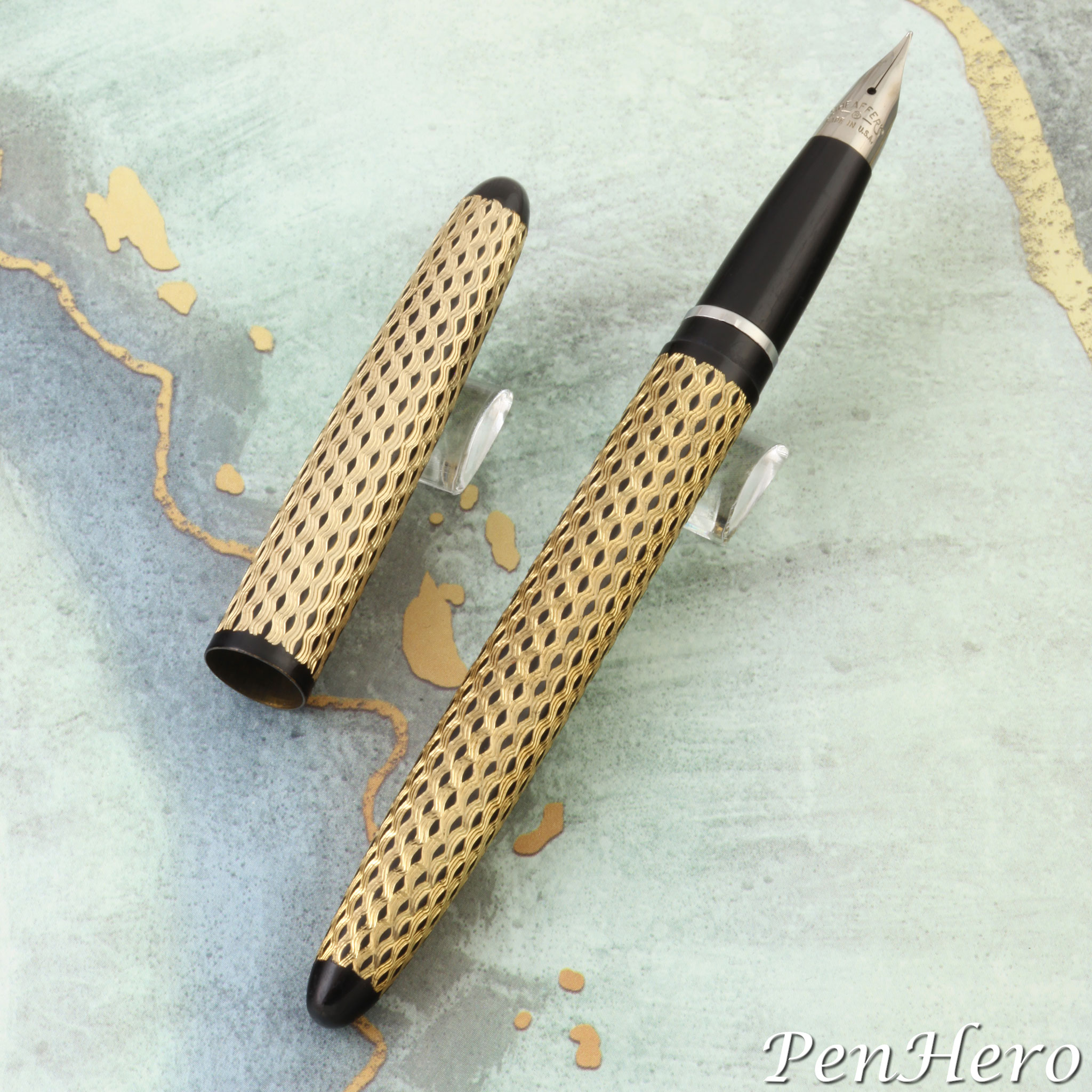 Lady Sheaffer IV Paisley
Lady Sheaffer IV Paisley
If you've ever written with a c. 1958-1959 conical nib Sheaffer Cartridge Pen fountain pen, then you will be familiar with how a Lady Sheaffer will write. The short conical nib is very firm and writes an even smooth line with a slightly pencil-like feel on paper.
Lady Sheaffer pens are very tactile given the engraved or brushed surfaces, but unfortunately many suffer from less than perfect execution and the finish of these pens often show chipped paint or plating loss. Even examples that initially look very clean sometimes exhibit spots without plating, sloppy plating, or tiny paint bubbles. In my opinion these pens were not made with high precision in spite of the premium price at the time and that shows even in some of the best surviving examples. Some engraved models actually show pattern variations in a side by side comparison that indicates there may have been consistency issues with the engraving process. This is most easily seen on the Petit Point pens, with some showing longer or shorter flowers, for example. The later clip Lady Sheaffers show a distinct improvement in manufacturing.
Being clipless, they aren't exactly pocket pens, but that is part of their charm. The engraving, the colors, the added details on certain models keep them interesting. There is nothing quite like these pens from this same period.
I rarely use the ones I have, primarily because I don't want to mar the finish on the better examples. I do have a few "user grade" ones that I have written with and they are indeed like fancy Sheaffer Cartridge Pens. They only use drop in Sheaffer Skrip Cartridges. They pre-date Sheaffer converters and really aren't intended for them. I don't post them as I worry that I will chip or scratch the finish. I've seen many examples that show scuffs from posting. Given the firm nibs and pencil like writing feel, my user impression is that they make good note takers and being clipless, the only real vice is the risk of rolling off the desktop!
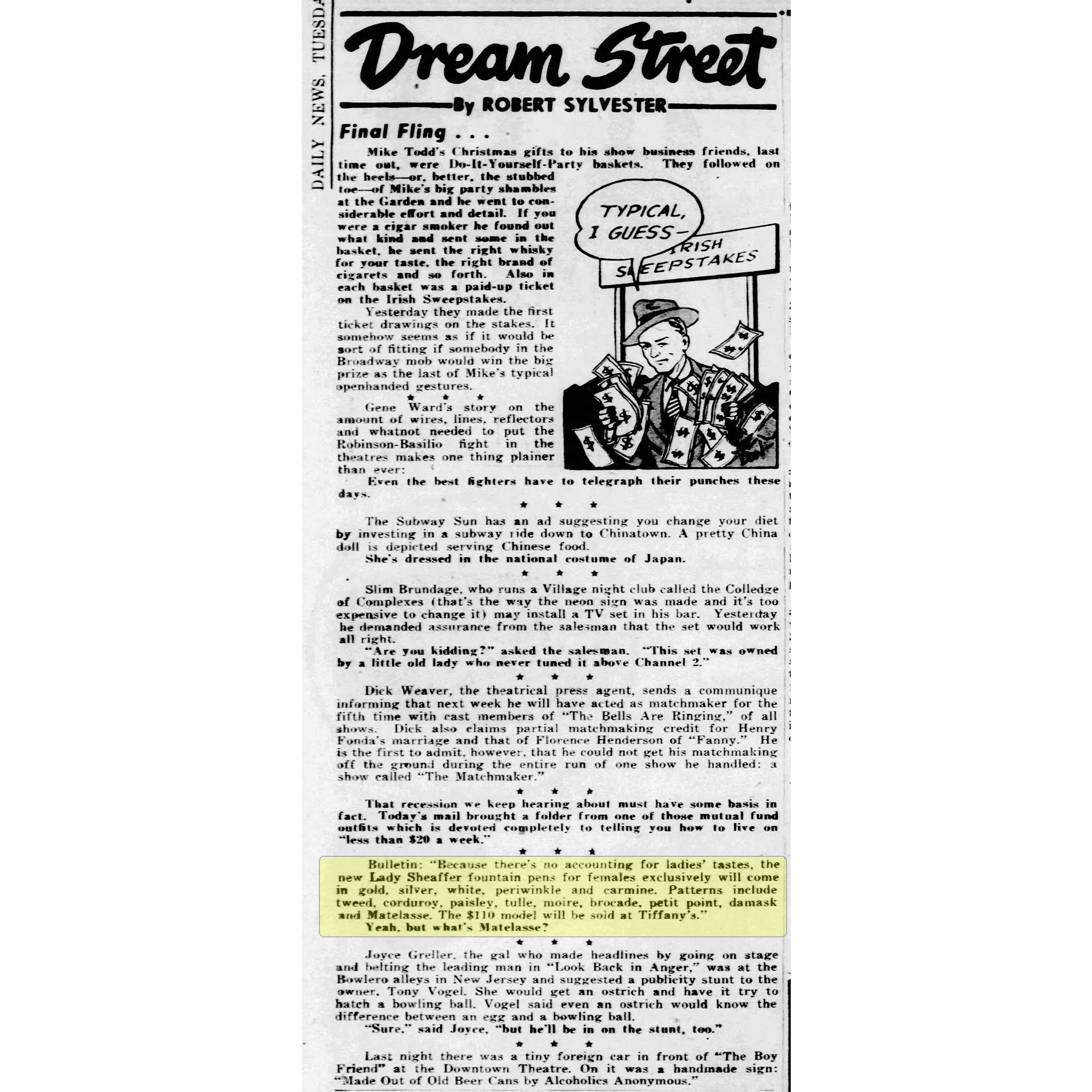 “Dream Street” by Robert Sylvester in the New York Daily News March 25, 1958, highlights the Matelassé model being offered at Tiffany's
“Dream Street” by Robert Sylvester in the New York Daily News March 25, 1958, highlights the Matelassé model being offered at Tiffany's
Lady Sheaffers are not uncommon, but some models are significantly more scarce than others. Availability in the field generally is as the original price goes up, fewer examples appear to exist. The model line appears to have been culled down to about five or six c. 1960, though I don't have exact confirmation on that. As of this writing I've not seen any confirmed example of a Matelassé other than some tiny photos on the Fountain Pen Network. I'm not certain if the images represent the real pen and they are not independantly confirmed as of this writing. The model definitely existed, and was at least carried by Tiffany in New York City, but who knows how many were made (probably a very small number considering the $110 price) and if any have survived.
Lady Sheaffer ephemera, such as the original tall, oval cardboard gift boxes and the fabric purse cases are very uncommon, especially in good to excellent condition. They may only have been made the first year or two of production. Later examples come in more ordinary Lady Sheaffer marked pen boxes. There are also striking countertop and window displays that would nicely round out a collection. The pencils are a little harder to come by than the pens and not all models have a matching pencil. These items alone could make up a long article.
Lady Sheaffer pens are often overlooked and in my opinion underpriced. A complete collection of the 18 available production models is not going to be excessively expensive to pursue, especially if less than mint condition examples are acquired. A challenge would be all four types of the Lady Sheaffer XV Moiré, especially since the rhinestones aren't always complete nor do internet photos always show the correct colors. For me, a nice example of the Damask was the hardest to find. There are also many uncatalogued clipless Lady Sheaffer pens that will be covered in a future article.
Acknowledgement
Thanks to Patrick Mohan for information on Lady Sheaffer pouches and information on the XV Moiré pen’s rhinestone variations.
Pennant Fall 2020
A version of this story appeared in the fall 2020 Pennant, the magazine of the Pen Collectors of America (PCA). You can learn more about joining the PCA and subscribing to the Pennant by clicking the link.
References
Advertisement, Ebony, June 1960, back cover
Advertisement, Ebony, December 1960, p. 102
Advertisement, Life, May 5, 1958, p. 63
Advertisement, Life, May 18, 1959, p. 110
Advertisement, Life, November 16, 1959, p. 60
“Competition Moves In…Other Firms Introduce Women’s Pens” Sheaffer’s Review, January 1959, p. 8
“Dream Street” by Robert Sylvester, New York Daily News, March 25, 1958, p. 46
“High Fashion Comes to the Pen Industry” Sheaffer’s Review, March–April 1958, pp. 5–6
Lady Sheaffer Catalog, 1959
“Lenox Writing Sets, With Custom Made China Bases, Skripsert Pen are Introduced” Sheaffer’s Review, May 1959, p.
“Marketing Review… Retail and Popular Price Divisions Prepare Massive Fall Promotions” Sheaffer’s Review, August 1960
“Marketing Review… Second TV Show Set; Ad Program Aimed at 500 Million Consumers” Sheaffer’s Review, October 1958, p. 4
Plewa, Fred, “New Lady Sheaffer” Pen World, V. 7 no. 6, August 1994, pp. 24–25
“A Report on Lady Sheaffer… Launching of New Pens is Highly Successful” Sheaffer’s Review, May 1958, p. 8
Sheaffer Catalog, 1963
Sheaffer’s Service Manual, 1962
Sylvester, Robert, “Dream Street” New York Daily News, March 25, 1958, p. 46
“Two More Firsts… Lady Sheaffer Pencils, New Writing Fluid are Introduced” Sheaffer’s Review, September 1958, p. 2
U.S. patent no. D187315, awarded February 23, 1960
Interact
Comments on this article may be sent to the author, Jim Mamoulides


